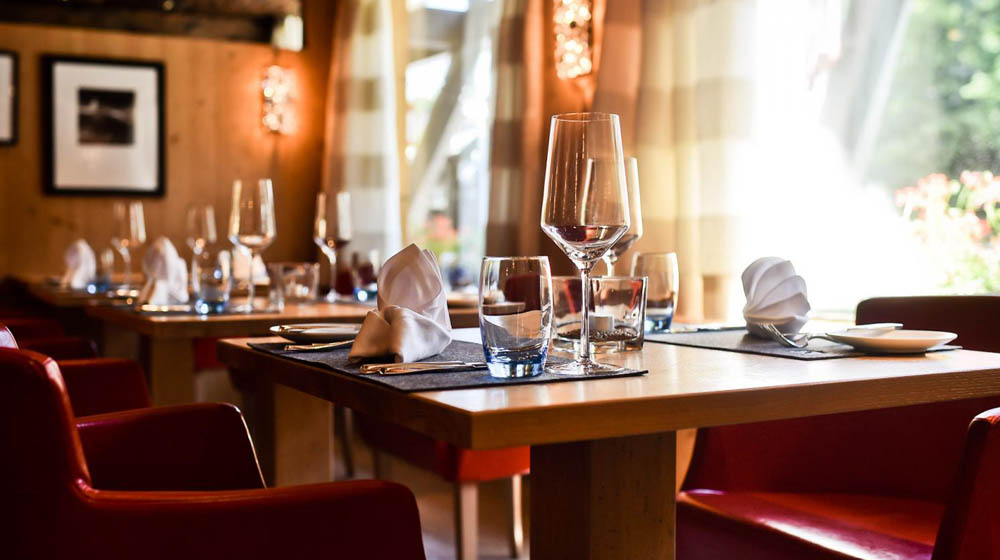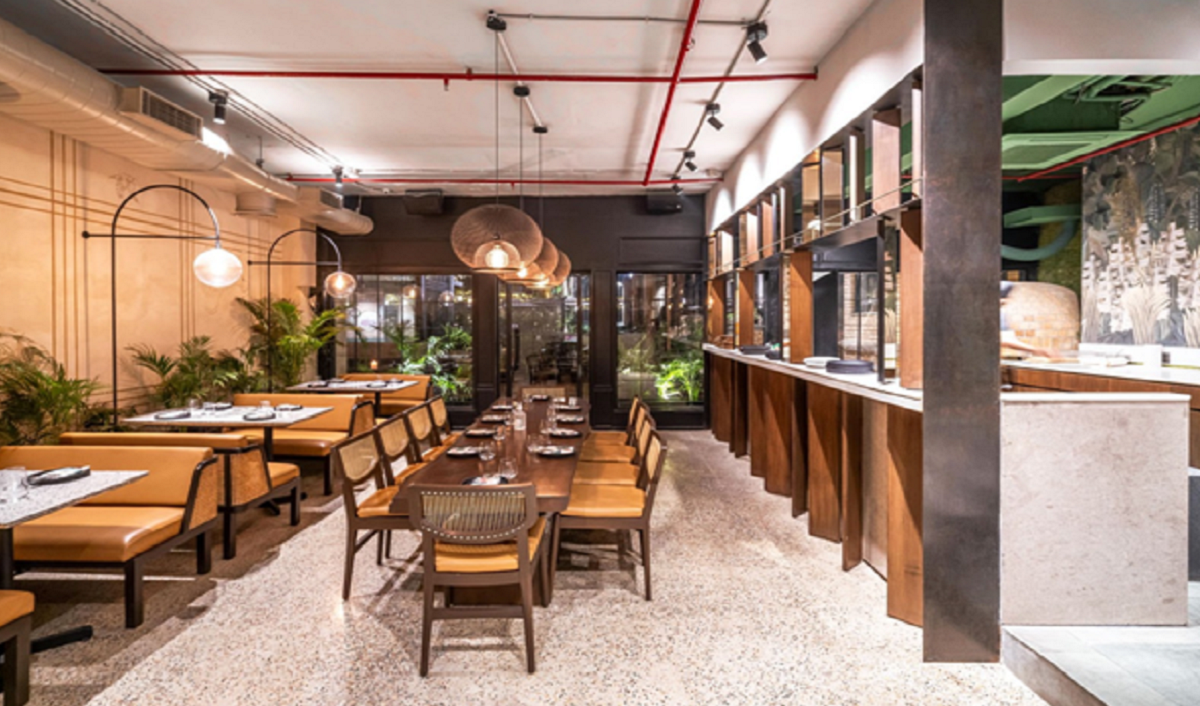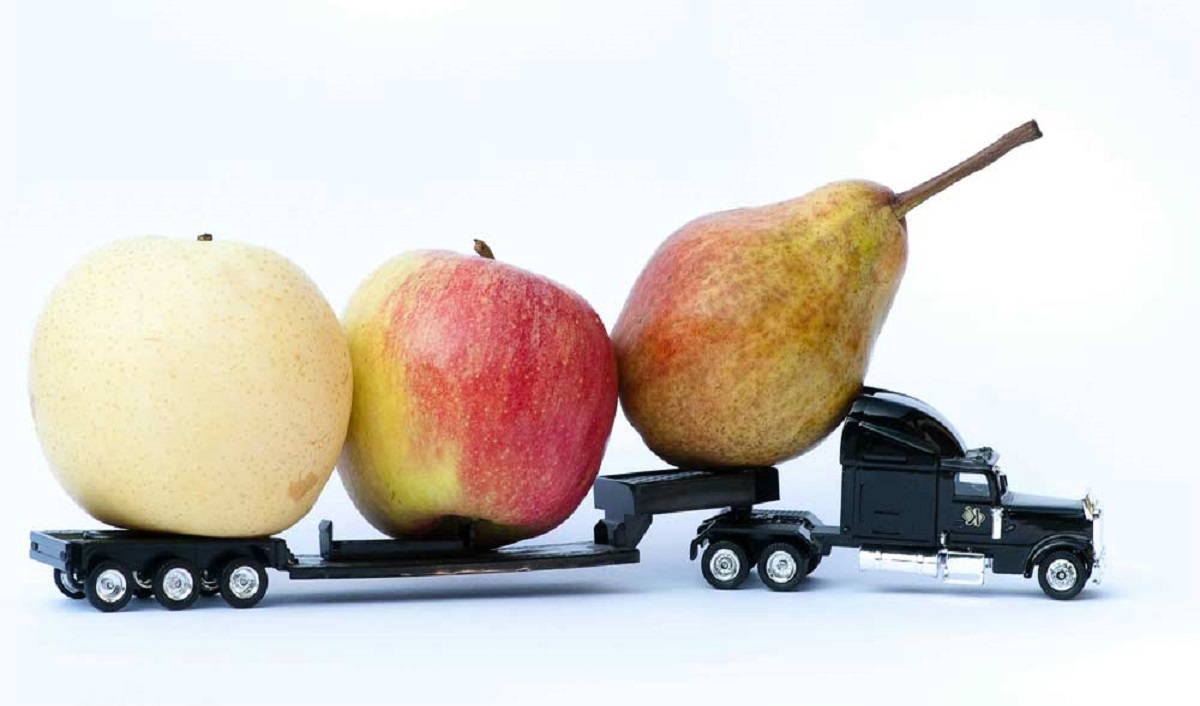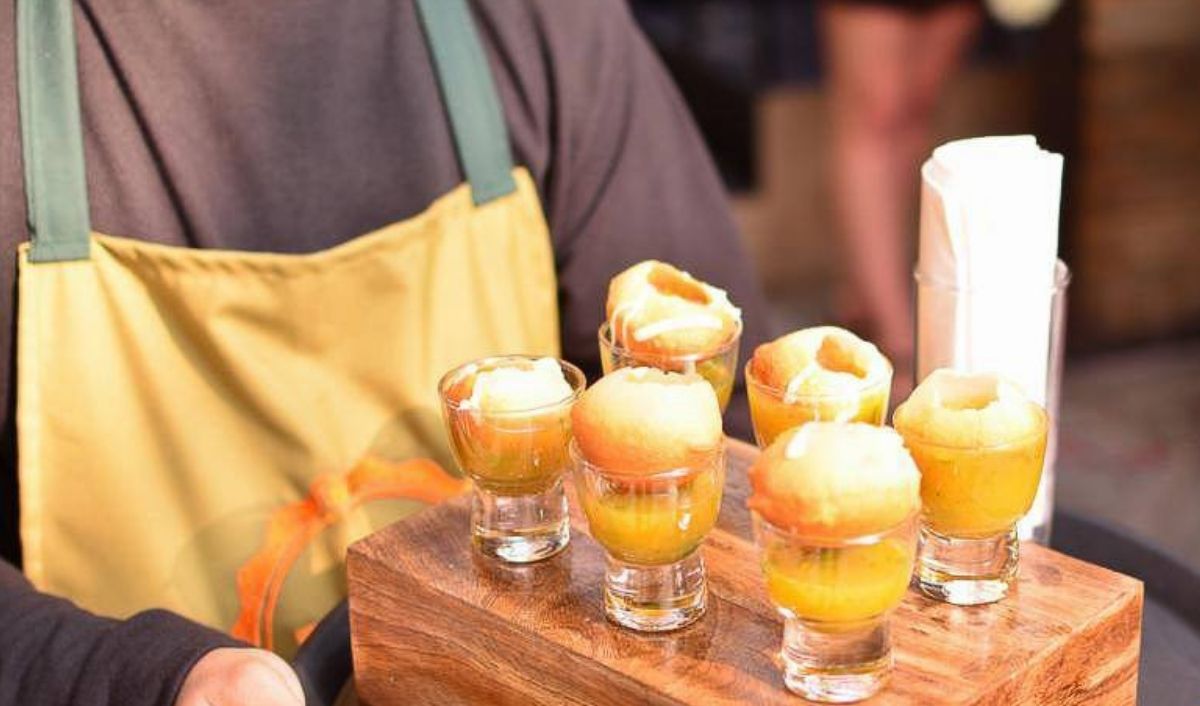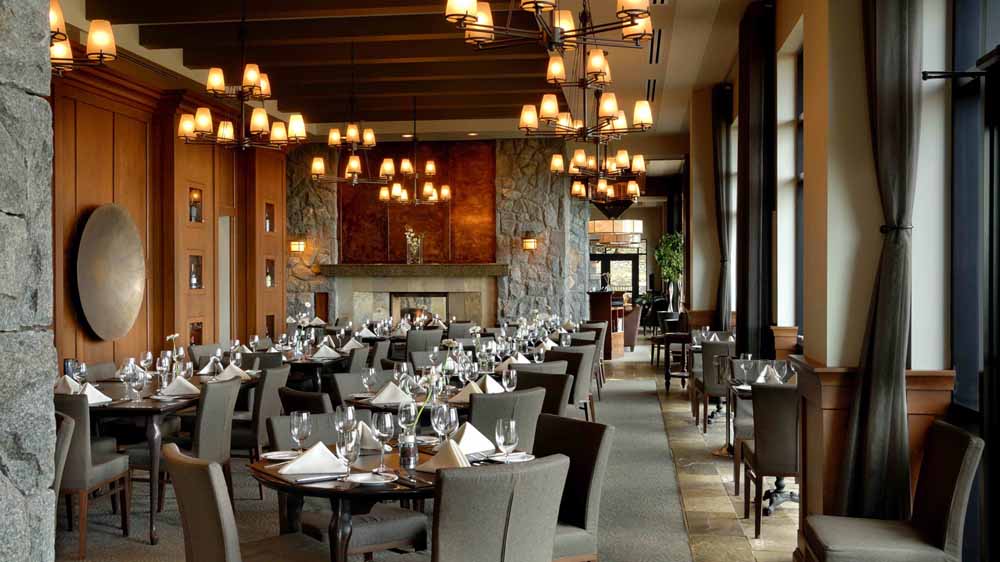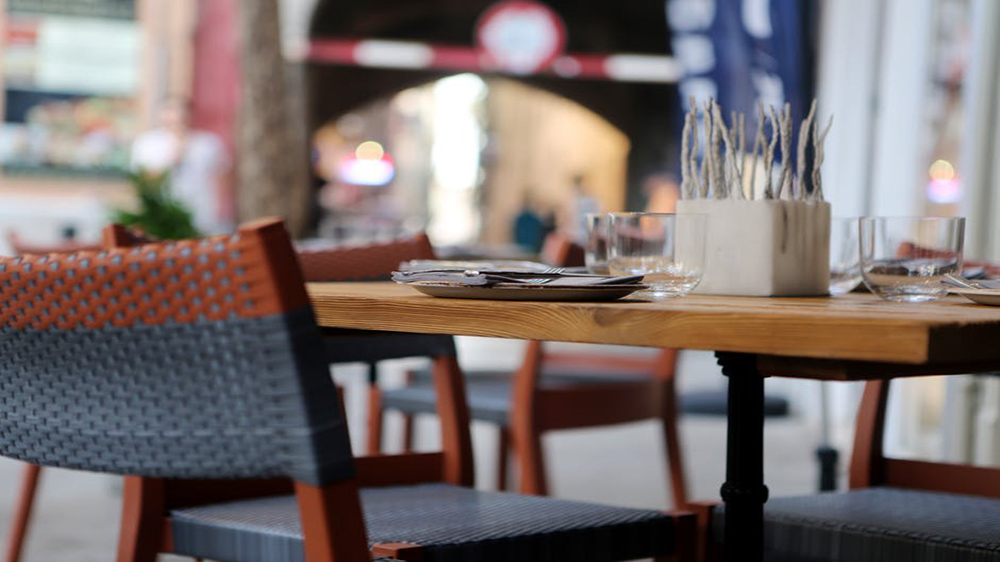
Music has played an important role in life but have you ever wondered how music can change the way we see it!
For a restaurant business, music is considered more than the décor and slightly less important than the food it serves. When it comes to making business successful, music has been proved to be a boon, especially in restaurant business.
One might not even notice the tune or wordings of the music played in the background while in a restaurant, but it surely makes a difference.
India’s food and beverages (F&B) industry is growing at a rapid pace of 10% from USD 48 billion in 2016 to reach USD 77 billion by 2021, says NRAI Food Service report.
Today, the industry is going through an exciting phase where country’s private final consumption expenditure accounts for 60% of the total GDP and is predicted to reach USD 2.4 trillion by 2021.
It works as an appetizer:
Listening to the noise of cutleries, while your order is yet to come, develops a sense of irritation which leads to disinterest in the food, so when music is played, it suppresses the noise of plates and spoons from the ambience, it keeps the interest of the customer intact.
Music also helps in holding the curiosity for the food ordered by the customer; more or less it works as an appetizer.
Makes the customer chew faster:
Studies have shown that slow tempo music has resulted in patrons spending more time during their restaurant visits. However when patrons are exposed to upbeat restaurant music, the number of bites and sips per minute increases, which makes the customer order more food and drinks, while enjoying the music.
Drinks cost a lot more than food items and people order more of drinks when they are in an aura, of loud music. Even posh crowd love to have their favorite expensive glass of wines, while swaying with softer notes.
Keeps the employee energized to work happily:
Studies have also shown that when music is playing in the background, the brain secretes dopamine, which triggers the adrenaline hormone and lets people work more. So music also helps in making the staff work more that too happily.
Staff which are constantly serving, cleaning tables, taking orders need to be active and happy, music helps in driving them active and happy.
Happy staff, happy customer, what more can a business ask for being successful. Thus music is considered more than just a décor.
Keeps the customer engaged:
The chef or whosoever is preparing the food, ordered by the customer needs certain time span to prepare it and place it on the table for the customer. If the restaurant happens to be crowded, there are high chances of making the customer leave and look for other options, which is where role of live music comes into play.
Live music, where the artists are playing or simply an artist playing an instrument adds a lot to the colors of the restaurant, moreover it will keep the customer engaged till a level that he/she won’t even realize their waiting time. Even the customer won’t mind paying extra tip for the pleasant experience.
Sets the mood right:
Food is a therapy for four sensory organs and music adds to the left one. So a combination of good food and good music releases happy hormones in people; a happy customer is the key to successful food business.
“With growing number of workforce in corporate and IT sector, demand for eating out has also risen up. Restaurants are coming up with diverse options from exotic dining options to healthy options. Customers are also more aware about various cuisines and want mix of both home food options to street food options,” says Pariekshit Madishetty, MD, Grid Logic Hotels and Resorts.

As summer has arrived, we can see restaurants focusing on fresh, light and seasonal ingredients. Summer menu is pretty common in restaurants and hotels, and it has strategic reasons behind the same and it allows restaurants to incorporate seasonal fruits and vegetables, bringing freshness and variety to their offerings. It also helps attract a new audience by offering exclusive dishes that celebrate the season’s produce, encouraging first-time visits and returning guests alike. From fruity mocktails to refreshing salads and globally inspired light bites, these menus are carefully curated to charm the palate and the pocket. But what’s the real reason behind this seasonal shift? Turns out, there’s a smart strategy cooking behind those tropical plates.
Summer Business Benefits
All restaurants and hotels do focus on their business or have a target to achieve with the specific menu launch. Let’s hear what experts has to say.
“From a business perspective, launching a summer menu has multiple advantages—it serves as a strong promotional tool, drives brand engagement, and give customers a compelling reason to return. Limited-time offerings also create a sense of urgency and exclusivity, which can boost footfall and enhance visibility. We typically keep it concise and curated, featuring around 8–12 seasonal dishes max and 4–5 cocktails or mocktails, depending on the brand and concept," explains Niketa Sharma, Managing Director, Keish Hospitality.
She adds, "Limited-time offerings create a sense of urgency and exclusivity which boosts footfall. We usually keep it curated around 8-12 seasonal dishes and 4-5 refreshing beverages depending on the brand."
Meanwhile, Chef Rohit Tokhi, AVP, Toscano pointed that restaurants usually do an offering to bring in a seasonal change to their menus. This brings in the best of seasonal offerings to feature in our menus such as melons, mangoes, stone fruits and a variety of lettuce. We add a supplement menu as an addition to our regular a la carte offering. However, a 15% addition would be a good target.
“It allows restaurants to do upselling and give more options for guests to choose over their regular menus. There is an upside to the sales to the tune of 10%-15%. More than the actual returns on menu, it brings in customer retention with our regulars and gives our guests a chance to experience a variety of menu,” added Rohit.
Knowing Their Guests
For every brand, the target audience may differ, and they cater to only those specific audiences. Speaking about this, Chef Sagar Thite, Brand Head, Prraia said, “If the guests’ preferences are prioritized as good hospitality demands, the benefits come our way. We as chefs benefit too through R&D and the chance to display our creativity especially if it’s beyond mangoes. We’ve always maintained a menu that has very little fried food & our flavours aren’t heavy on the palate. For us, it’s a mix of tourists, expats & people who are out there to experiment with summer flavours.”
Chef Ayush Khandelwal, Co-founder of Paro said, “The summer menu is primarily designed to re-target our regular customers with fresh, seasonal choices. It appeals to health-conscious diners, seasonal food lovers, and those seeking lighter options during the warmer months. The aim is to give familiar faces something new and exciting to come back for.”
The Crowd-Pleasers
Every season has different summer favorites. Last year, it was more about mangoes, the innovations and going back to the roots and much more. “Last year, our Mango Smoothie with Chocolate Popsicle and the Star Anise Salad were among the most loved dishes at The Thane Club,” added Niketa.
As the industry is booming, they're not just curating for the plate, but also for the experience - seasonal storytelling through ingredients, presentation and feel-good vibes.

In today’s world, social media is the game-changer for restaurants aiming to build their reputation. What once was just a place to share food photos has evolved into a powerful marketing engine that can propel restaurants into the spotlight—or sink them with a single bad review. It's not just about pretty pictures anymore; it’s about managing the buzz and ensuring a loyal customer base. And trust us, Instagram reels and influencer shout-outs can either bring floods of customers or tarnish your brand overnight.
Let’s face it: in the age of digital media, every guest’s experience is public property. A single negative comment can do more damage than you can imagine. On the flip side, a glowing review can drive more business than any ad campaign. Reputation is everything, and how you manage it can make or break your restaurant. This is where online reputation management becomes your secret weapon for success.
The Power of Social Media in Shaping Restaurant Reputations
1. Visibility & Reach: Social media is a megaphone for your restaurant, letting you amplify your presence and engage with customers worldwide.
2. Customer Interaction: It’s no longer just a platform for posting updates. It’s a real-time conversation with your patrons, building trust and loyalty.
3. Influence on Perception: While positive posts can elevate your brand, negative reviews can spread like wildfire. Managing this delicate balance is essential.
Pro Tips for Managing Online Reviews
1. Constant Vigilance: Keep an eye on review sites like Google, Yelp, Zomato, and TripAdvisor—don’t miss a single mention!
2. Swift Responses: Respond to both good and bad reviews quickly. Show customers you care, and they’ll come back for more.
3. Encourage Positive Reviews: Prompt happy customers to share their experiences. A flood of positive reviews can bury any negative ones.
Sidney Dcunha, Director of Food and Beverage & Culinary at Sofitel Mumbai BKC, emphasizes, “Effective management ensures that social media becomes an ally in sustaining and growing our restaurant’s reputation. With the rise of digital reservations, online payments, and loyalty programs, safeguarding customer data is a non-negotiable priority.”
Tackling Negative Criticism Like A Pro
“We take our guests' privacy and security extremely seriously. We respect our guests' privacy at all times and work to ensure they feel safe in their interactions with us,” says Christina Roach, Director for Radisson Blu Bengaluru Outer Ring Road. While negative reviews can be disheartening, they’re an opportunity to improve your game. Address criticism professionally, and you'll turn an upset guest into a loyal customer.
Shahrom Oshtori, Co-founder of Sixteen33, agrees: “Negative feedback can spread quickly, making reputation management crucial. We assess it based on how we respond—whether we take corrective actions or offer a better experience.”
How to Maintain Data Privacy and Keep Your Restaurant Secure
1. Adopt Secure Technologies: Always use encrypted payment gateways and secure reservation systems to protect customer data.
2. Train Your Staff: Make sure everyone is aware of how to handle sensitive information responsibly.
3. Be Transparent: Clearly communicate your data handling policies to customers. Compliance with laws like GDPR is a must.
Why Marketing is a Game-Changer for Your Restaurant
1. Increased Awareness: Partnering with influencers expands your reach to untapped audiences and builds buzz around your brand.
2. Credibility & Trust: When influencers rave about your restaurant, their followers trust them—and your restaurant reaps the benefits.
3. Engagement Boost: Influencer posts aren’t just eye-catching—they drive foot traffic and boost sales.
Dharmendra, COO of Gigu Hospitality, explains, “Increased Awareness, Credibility, and all these factors play an important role in developing the business.”
Navigating Influencer Marketing Challenges
1. Finding the Right Fit: Not all influencers will align with your restaurant's brand. Choose wisely to avoid mismatched messaging.
2. Measuring ROI: Tracking the direct impact of influencer campaigns on sales and foot traffic can be tricky.
3. Managing Expectations: Ensure that influencers represent your restaurant in a way that matches your image and values.
Overcoming Influencer Marketing Hurdles
1. Do Your Research: Pick influencers whose audiences align with your target demographic.
2. Set Clear Expectations: Outline deliverables and goals upfront to avoid misunderstandings.
3. Track Success: Use tracking tools and discount codes to measure the ROI of influencer campaigns effectively.
In the digital age, social media and influencer marketing are not just trends—they are crucial tools for building a loyal customer base and driving profits. By actively engaging with your audience and addressing feedback constructively, you can establish a reputation that not only attracts customers but keeps them coming back for more.

Amazing food is only the start in the fiercely competitive food and beverage (F&B) sector of today. Restaurants have to make an investment in their logo, ambiance, and brand colors if they want to provide a memorable eating experience. Together, these components influence consumer impressions, improve the whole experience, and create enduring bonds with the brand.
The Significance of Brand Colors
Brand colors affect behavior and elicit particular feelings in addition to being merely aesthetic choices. For example, fast-food chains frequently utilize bright colors like red and yellow to pique customers' appetites and energy levels, whereas fine dining venues may choose to communicate luxury with deep blues or golds. When a restaurant's color scheme is appropriate and consistent throughout all brand touchpoints, it strengthens its identity and increases its instant recognition. The psychology of color is a potent weapon for influencing dining decisions and building an emotional bond with the audience since it is fundamental to how consumers view and engage with the business.
Ambience: Establishing the Tone
In order to define the dining experience, ambience is essential. It covers everything, including furniture, design, even music and lighting. Whether it's the loud, dynamic mood of a burger joint or the cozy, romantic setting of an Italian restaurant, a well-designed atmosphere impacts how customers enjoy the cuisine. In order to provide a seamless and pleasurable dining experience, the ambience should complement the restaurant's concept and target demographic. Bright colors and lively music, on the other hand, would be appropriate for a hip café, while soft lighting and comfortable seats might be perfect for an upscale eating experience. A welcoming atmosphere can entice clients to remain longer, place larger orders, and visit again in the future.
The Brand's Visual Identity: The Logo
The face of a brand is its logo, which is frequently the first thing that consumers see. It need to be uncomplicated, unique, and representative of the character of the eatery. Strong logos act as a visual reminder of satisfying dining experiences, which promotes brand loyalty. It must be adaptable, functioning effectively across a variety of media and platforms, including menus and internet marketing. Investing in expert design is essential since a well-designed logo can come to represent quality and reliability. Along with the brand, the logo should alter to keep it appealing and current with shifting consumer tastes and trends.
The Value of Comprehensive Branding
To stand out in the F&B market, a brand identity that is consistent is necessary. Restaurants can stand out, make lasting impressions, and entice repeat business by carefully combining their brand colors, atmosphere, and logo. Serving delicious cuisine is only one aspect of holistic branding; another is creating an atmosphere that draws clients in and encourages them to come back time and time again. Word-of-mouth marketing is another benefit of having a strong brand identification. As patrons tell their friends and family about their experiences, the restaurant's reputation and reach grow even more.
Why Food Isn't Sufficient on Its Own
Though they are very important, food quality and flavor are only a small component of the whole eating experience. Customers of today look for experiences that appeal to all of their senses rather than simply a simple meal. Herein lies the significance of branding. Customers can have a deeper connection to a business with the correct color scheme, ambiance, and logo, which can elevate an ordinary dinner to an amazing experience. The goal is to create a setting where the cuisine, surroundings, and brand identity all complement one another to offer a complete and unforgettable dining experience.
The eating experience is completed with the brand colors, atmosphere, and strong logo, even though the food is the main attraction. Together, these components forge a distinctive character that draws clients and guarantees they leave with favorable perceptions, enabling the business to prosper in a crowded market. Making an emotional connection with consumers through branding investments fosters client loyalty, repeat business, and long-term success. It's not just about looks. The future of dining is about how the entire experience connects with the diners, not simply what's on the plate.

Flavorings are components that give food flavor and uniqueness. The first people to use fragrant substances into their diet were the ancient Egyptians. Due to their frequent usage in food and drink, flavours have a profound cultural legacy and arouse intense emotions and memories.
The Flavorings promote more balanced eating habits by allowing consumers to enjoy better food alternatives. A number of factors, including growing consumer preference for natural and healthier food options, rising demand for convenience foods, rising disposable incomes, improvements in food processing technologies, and the worldwide growth of the food and beverage industry, are driving the food flavors market.
The flavors market was valued at USD 18.75 billion in 2023 and the market is expected to grow from USD 19.53 billion in 2024 to USD 30.10 billion by 2032, exhibiting the CAGR of 5.6% during the forecast period.
Natural Ingredient is the Hero
“We use natural flavors with every dish we cook. Our commitment is to use the real, high-quality ingredients shine through in every menu item. For instance, our Greek Quesadilla is crafted with authentic feta cheese and fresh herbs, delivering a genuine taste of Greece. Our Margarita pizza consists of sun-ripened tomatoes and fresh basil, ensuring a vibrant, classic flavor. Our Ratatouille is full with the richness of locally-sourced vegetables, while our Sizzlers offer a sizzling array of ingredients cooked to perfection. Our Eggs Benedict is made with farm-fresh eggs and hollandaise sauce, and our Asparagus Risotto is prepared with tender, seasonal asparagus and rich, real Parmesan cheese,” said Rahul Bajaj, Founder, Out of the Blue, Mumbai by adding that we avoid artificial flavors and focus on natural ingredients by providing an unforgettable dining experience that celebrates the true essence of each dish.
Evolution of Natural Flavours in Cooking
Over the years, there has been a significant shift towards using natural flavours in the kitchen. This change is driven by growing awareness of health benefits, environmental concerns, and a desire for authenticity in food. Traditionally, most cuisines relied on natural flavours from herbs, spices, and fresh ingredients.
In Indian cooking, spices like turmeric, cumin, coriander, and fresh herbs such as cilantro and mint were commonly used to enhance flavors. With the advent of the industrial age, artificial flavours and sweeteners became popular due to their cost-effectiveness and long shelf life. These were widely adopted by food manufacturers and restaurants for convenience.
“In recent decades, there has been a backlash against artificial additives due to their potential health risks. Consumers are now more conscious of what they eat, preferring natural and organic options. Understanding the true nuances of flavours through the use of natural spices requires experience and expertise,” commented Chef Sudhir Pai, F&B Consultant, TAT, Mumbai who elaborated that the retaining flavour in traditional cooking which we follow at Tat Coast Cuisine restaurant includes slow and traditional cooking methods help in retaining the flavours of natural ingredients, techniques like tempering (tadka) release the essential oils of spices, enhancing the overall taste, balance of spices is crucial.
Too much of one spice can overpower others, traditional recipes often provide a good guide, but experimentation is key to finding the perfect blend, Indian cuisine involves various processes that help retain the taste, colour, and texture of natural ingredients like dry roasting whole spices before grinding can intensify their flavours and slow cooking methods like simmering and braising allow flavours to meld together, creating complex and rich dishes.
Driven by Health Concerns
“Over the years, the use of natural flavors in the kitchen has evolved significantly. Initially driven by health concerns and growing awareness about artificial additives, chefs and food manufacturers have increasingly turned to natural ingredients. This shift emphasizes clean labels, where consumers can recognize and trust the ingredients listed,” said Richa Sanghvi, Founder, Epitome, Mumbai.
Replacing artificial sweeteners with organic or natural alternatives like honey, maple syrup, and stevia has become popular. These substitutes not only offer a healthier option but also enhance the flavor profiles of dishes, catering to the demand for guilt-free treats. This trend aligns with the broader movement towards sustainability and holistic wellness, promoting a balanced and nutritious diet without compromising on taste.
Maintaining Nutritional Value
“We believe that the use of natural flavors in our kitchen is a game-changer. Over time, we have moved away from artificial additives to embrace organic and natural ingredients, which not only enhance the taste of our dishes but also maintain their nutritional value,” explained Chef Stefan Gadit, Executive Chef, Torii, Mumbai.
Replacing Artificial Sweeteners with Natural Sweeteners
The move towards natural sweeteners is part of a broader trend towards healthier eating. Natural sweeteners like honey, maple syrup, and organic jaggery are becoming popular alternatives to artificial sweeteners and refined sugar. Natural sweeteners often contain additional nutrients and antioxidants. They have a lower glycemic index, which helps in managing blood sugar levels.
Organic jaggery is a traditional sweetener used in many desserts. It is unrefined, retaining more minerals compared to refined sugar. It adds a unique, rich flavour and is considered healthier.
“Replacing artificial sweeteners with natural alternatives like honey, agave, and maple syrup allows us to offer guilt-free treats that our customers love. This shift has significantly improved the quality of our food, providing a more authentic and wholesome dining experience,” added Chef Stefan Gadit, Executive Chef, Torii, Mumbai who said that the commitment to natural flavors is a testament to our dedication to serving high-quality, delicious, and healthy meals.
Using Natural Sweeteners
These alternatives are not only healthier but also add a distinct flavour.
"Many recipes are being adapted to reduce the overall sugar content, focusing on natural sweetness from ingredients like fruits,” said Chef Sudhir Pai, F&B Consultant for TAT, Mumbai highlighted that incorporating natural flavours and sweeteners, makes it possible to create delicious and healthier meals that honour traditional cooking techniques while meeting modern dietary needs, Organic jaggery, honey, and dates are being used more in traditional sweets.
Commenting on the same, Chef Prasad Parab, Head Chef, Amoeba, Mumbai shared, “We are commitment to genuine flavors means we do not use artificial additives in favor of natural ingredients. For example, we incorporate dehydrated beetroot powder in our hummus, enhancing its color, adding a hint of sweetness, and providing extra nutritional benefits instead of using artificial colour. Similarly, our chocolate wontons are crafted with Nolan Gud, a traditional jaggery made from natural dates, to infuse our compound chocolate with a rich, authentic sweetness."
Future of Natural Sugar
By 2028, the regular sugar is gradually being replaced by natural sugar substitutes in the restaurant industry. We are switching from sugar-to-sugar replacements because they can be used in smaller amounts without compromising the product's flavor and appearance, which results in significant cost savings. Furthermore, consumers concerned about their health are now looking for better alternatives to refined sugar. The high daily consumption of refined sugar significantly contributes to many serious ailments, including diabetes, obesity, high blood pressure, and heart disease. The market for natural sweeteners is being driven by consumers' growing knowledge of such lifestyle disorders across the globe.

The restaurant industry's struggle with high turnover among its frontline and mid-level employees is becoming increasingly problematic. In 2023, this issue reached its zenith, marking a three-year high in attrition rates during a period of significant sector expansion. This expansion is shadowed by the challenges of long working hours and limited opportunities for career progression, factors that have contributed to the turnover crisis that began unfolding three years prior.
BetterPlace, in its detailed analysis, pinpointed quick service restaurants (QSRs) as the segment suffering the most from frontline worker attrition. The firm's fiscal year 2022 report uncovered that the monthly attrition rate in these sectors stood at an alarming 19%, suggesting that nearly one in every five employees opts to leave each month. The surge in demand for the services and products offered by these industries, both during and in the aftermath of the pandemic, necessitates a large and readily available workforce. The report emphasizes that the demanding nature of the jobs and the ease with which workers can be replaced are principal reasons behind the high attrition rates.
Challenges in the Restaurant Industry
Pravin Agarwala, co-founder and group CEO at BetterPlace, underscores the critical role of India’s frontline workforce in driving the country's economic growth across various sectors. “With the economy on a path to normalization, there's been a noticeable increase in the demand for frontline workers, leading to the creation of millions of jobs. According to Agarwala, the job market is expected to expand significantly, potentially creating up to 50 million jobs by the end of this decade,” he added.
The restaurant industry, however, is facing challenges in attracting the new generation of workers. Kabir Suri, president of the National Restaurants Association of India, highlights the decline in interest among young individuals, attributing it to the demanding and physically intensive nature of the work. This has resulted in a noticeable decrease in the number of students enrolling in professional hotel management courses.
The attrition rate within the restaurant sector reached a record 60% in 2023, as noted by Kartik Narayan, chief executive (staffing) at TeamLease Services. This represents a significant increase from the 50-55% average observed in previous years. “Factors contributing to this high turnover include erratic working hours and a stressful work environment. The sector's growth has also led to a competitive talent market, with businesses vying for mid-level and frontline staff through higher salaries and enhanced job benefits,” he commented.
Need for New Workforce Strategies
Recent trends in investment and funding have shown a resurgence, with both new local ventures and international chains being attracted by India’s young demographic. This has led to a proliferation of job opportunities, contributing to a faster turnover rate as employees seek better compensation packages.
A report by consulting firm Wazir Advisors forecasts substantial growth for India's organized food services market, projecting an increase to $78.8 billion by 2026 from $57.2 billion currently. Factors such as a higher frequency of dining out, increased disposable incomes, and urbanization are driving this growth. Despite facing slowed expansion due to heightened competition, QSR chains are aggressively pursuing expansion strategies. ICRA estimates suggest that these chains are set to open 2,300 new stores with an investment of Rs 5,800 crore between 2022-23 and 2024-25, underscoring the industry's resilience and its adaptability to changing market dynamics.
Moreover, the industry's landscape is being reshaped by technological advancements and changing consumer preferences. Digital ordering systems, contactless deliveries, and an emphasis on health and safety standards have become paramount. Restaurants are now tasked with not only managing the operational challenges posed by high attrition rates but also adapting to a rapidly evolving market where consumer expectations are higher than ever. To retain employees, businesses are increasingly focusing on creating a positive work culture, offering competitive salaries, and providing opportunities for growth and development. These strategies are crucial for addressing the root causes of attrition and ensuring the sustainability of the workforce in this vital sector.
Solutions and Future Directions
To mitigate the high attrition rates within the restaurant industry and safeguard jobs, a multifaceted approach involving both industry leaders and government intervention is essential. Businesses can take proactive steps by investing in employee training programs, offering clear paths for career advancement, and enhancing workplace conditions to make the sector more appealing to potential and current employees. Implementing flexible working hours, providing mental health support, and recognizing and rewarding employee contributions can also play a significant role in employee retention.
On the government's part, support can come in various forms to stabilize and grow the hospitality sector, thus preserving jobs. Policymakers could consider offering tax incentives or grants to businesses that commit to employee development and retention strategies. Additionally, government-funded vocational training programs tailored to the hospitality industry can equip individuals with the skills needed for long-term career success within the sector. Such initiatives not only benefit potential employees but also help businesses by increasing the pool of skilled labor.
The government can also facilitate partnerships between the private sector and educational institutions to update curriculum and training programs, ensuring they are in line with industry needs. This collaborative approach between the industry and government can lead to a more robust, resilient, and attractive restaurant and hospitality sector, ultimately resulting in lower attrition rates and more secure employment for frontline and mid-level workers.

Embarking on the journey of opening a restaurant is an exciting jouney, but it requires meticulous planning and strategic decision-making to thrive in a competitive landscape. Before you set foot in the kitchen, it's crucial to map out a comprehensive business plan that encompasses various aspects of your venture. Here are five essential components to consider before launching your restaurant, ensuring a solid foundation for success.
1. Choosing the Right Model of Expansion
The first step in your restaurant business plan is to determine the model of expansion that aligns with your vision and resources. Will you operate solely offline, leverage cloud kitchens for delivery services, or adopt a hybrid approach combining both? Each model has its own set of advantages and challenges, so it's essential to evaluate which one best suits your concept and target audience.
2. Deciding on the Investment Mode
Financing plays a pivotal role in realizing your restaurant dream. Whether you opt for internal funding, seek loans, attract equity investors, or consider franchising, it's crucial to weigh the pros and cons of each option. Internal funding offers autonomy but may limit resources, while franchising provides capital infusion and brand exposure but entails relinquishing some control. Assess your financial capabilities and growth objectives to determine the most suitable investment mode for your restaurant venture.
3. Strategic Partnerships and Approach
Once you've outlined your expansion model and investment mode, it's time to approach bankers or potential franchising partners. Present a compelling business proposal highlighting your concept, market research, financial projections, and growth strategy. Whether you're seeking funding or exploring franchising opportunities, articulate how your restaurant concept stands out in a crowded market and how investors or partners stand to benefit from collaborating with you.
4. Telescope: Prepare Your Five-Year Plan and Solve for Scale
A successful restaurant venture requires a long-term vision and a roadmap for growth. Develop a detailed five-year plan outlining your expansion goals, revenue targets, operational milestones, and strategies for scaling your business. Anticipate challenges and devise contingency plans to navigate market fluctuations and evolving consumer preferences. By forecasting your trajectory and addressing scalability early on, you position your restaurant for sustainable growth and profitability.
5. Microscope: Don't Lose Focus on the Essentials
Amidst the excitement of expansion and growth, it's imperative not to lose sight of the core elements that define your restaurant's success. Quality, taste, and the overall dining experience are non-negotiable factors that drive customer satisfaction and loyalty. Uphold stringent standards in food preparation, service delivery, and ambiance to consistently exceed customer expectations. Remember, maintaining excellence in these fundamental aspects is key to sustaining your restaurant's reputation and staying ahead of the competition.
In conclusion, crafting a robust business plan is essential for laying the groundwork for a successful restaurant venture. By carefully considering your expansion model, investment mode, strategic partnerships, and long-term growth strategy, you can set your restaurant on the path to prosperity. However, while planning for expansion, never lose sight of the core values that define your brand – taste, quality, and exceptional customer experience. With a well-rounded approach that balances vision with attention to detail, you can turn your restaurant dream into a thriving reality.

In the dynamic landscape of the culinary world, where flavors tantalize taste buds and ambiance sets the mood, restaurants must navigate the realm of marketing to thrive. In 2024, restaurants must harness a diverse array of strategies to captivate audiences and secure their place in the hearts and minds of diners. From digital prowes to community engagement, here are eight groundbreaking restaurant marketing strategies to elevate your establishment's presence in the dining scene.
1. Craft Compelling Email Campaigns
In the digital age, the power of email marketing remains unparalleled. With automation features, restaurants can forge direct connections with customers, fostering positive engagement and influencing dining decisions. By striking the delicate balance between frequency and relevance, restaurants can leverage email campaigns to cultivate a loyal customer base.
2. Unlock the Potential of SMS Marketing
Harnessing the immediacy of SMS marketing, restaurants can capture attention with enticing messages. While the click-through rate may be modest, the high open rate presents an invaluable opportunity. From exclusive discounts to event tie-ins, SMS marketing offers a direct line to diners, inviting them to indulge in culinary delights.
3. Seize Control of Online Listings
In an era dominated by digital discovery, the importance of curated online listings cannot be overstated. By claiming and updating listings on platforms like Facebook, Google, Yelp, and TripAdvisor, restaurants assert their online presence and attract new customers. Empowered with control over their digital narrative, restaurants can strategically position themselves for visibility and acclaim.
4. Leverage Influencer Partnerships
Influencers wield considerable sway in shaping consumer preferences, making them valuable allies in the restaurant marketing landscape. By collaborating with local influencers and leveraging their expansive social media reach, restaurants can amplify their brand presence and cultivate a devoted following. From renowned foodies to hometown heroes, influencers offer a powerful platform for showcasing culinary excellence.
5. Cultivate Community Connections
Beyond the confines of the dining room, restaurants have the opportunity to make a meaningful impact in their local communities. Whether through charitable partnerships or philanthropic initiatives, restaurants can embody values of compassion.
6. Embrace the Return of Physical Menus
While digital menus have their place, the menu beckons diners with its tangible appeal. By offering physical menus alongside digital alternatives, restaurants cater to diverse preferences and enhance the dining experience. With clear, visually appealing menus, restaurants set the stage for culinary exploration and elevate the art of dining.
7. Spotlight Stellar Staff
Behind every exceptional dining experience are the dedicated individuals who bring it to life. By showcasing the personalities and talents of their staff, restaurants humanize their brand and foster a sense of familiarity. From kitchen maestros to charismatic servers, highlighting the individuals behind the scenes adds depth to the dining narrative and strengthens customer connections.
8. Cultivate Organic Advocacy
In the realm of restaurant marketing, there is no substitute for genuine word-of-mouth endorsement. By delivering exceptional culinary experiences and service, restaurants cultivate a loyal base of advocates who eagerly spread the word. From tastings at local establishments to collaborations with business organizations, restaurants can organically expand their reach and solidify their status as culinary destinations.
In the dynamic landscape of restaurant marketing, innovation is the key to success. By embracing these strategies, restaurants can navigate the complexities of the digital age while forging authentic connections with patrons, ensuring a seat at the table of culinary distinction in 2024 and beyond.

The Hotel And Restaurant Association (Western India) – HRAWI has recently voiced its concern over the current GST structure affecting restaurants within hotels, particularly those linked to room tariffs above INR 7500. The association points out that this taxation model puts hotel-based restaurants at a significant disadvantage compared to standalone restaurants and calls for a crucial overhaul of the GST rates applied to them. HRAWI is advocating for the separation of GST rates for restaurants from hotel room charges, proposing that all restaurants be taxed uniformly, regardless of their location within hotels.
HRAWI's President, Pradeep Shetty, remarked on the issue, stating that the current GST linkage to room rates unfairly burdens hotel restaurants, especially when attracting walk-in diners. The leap in GST from 5 percent to 18 percent for room tariffs over INR 7500 introduces a level of unpredictability for customers and places hotels at a competitive disadvantage.
This practice, according to Shetty, discriminates against hotel restaurants compared to their standalone counterparts, despite offering similar quality dining experiences. The association has made a plea to the government for the standardization of GST rates across all dining establishments to foster fair competition and ensure the industry's longevity, aiming for equitable treatment of all restaurant categories.
The Association also highlighted how this GST disparity adversely affects larger hotel chains in attracting walk-in guests and complicates banquet service offerings, leading to customer dissatisfaction and operational challenges.
Shetty emphasized the importance of creating a level playing field in the hospitality sector by standardizing GST rates for food and beverage services across the board. This adjustment is deemed essential for nurturing a competitive environment, promoting fair practices, and securing the hospitality industry's future.
Echoing HRAWI's sentiments, Siddharth Renganathan, Co-Founder of Suvaii, added, “As the founder of Suvaii, I echo the concerns raised by the Hotel and Restaurant Association (Western India) – HRAWI regarding the current GST framework for restaurants within hotel premises. The existing structure, tying GST rates to room charges exceeding INR 7500/-, poses challenges for establishments like ours. We support the HRAWI's advocacy for reform, calling for uniform GST rates for all restaurants, regardless of their association with hotels. This change is essential for creating a level playing field, promoting growth, and ensuring a fair environment for restaurants to thrive within the hospitality sector.”
According to Kabir Suri, co-founder & Director of Azure Hospitality Pvt Ltd, “Balanced, fair and equitable policies by the government with respect to GST input tax credit, rationalised licensing norms and e-commerce policy will not only benefit businesses and consumers but also make a substantial contribution to overall economic growth and employment opportunities."
Since 2018, hoteliers have been vocal about their concerns that this tax variation is causing a decline in restaurant footfall, as customers opt for standalone restaurants to leverage tax advantages. Industry stakeholders are advocating for a standardized GST rate of 5% across all dining establishments to create a level playing field. Amidst the thriving performance of standalone restaurants nationwide and the already intense competition, the hotel industry is questioning the rationale behind linking hotel room rates to dining preferences.
Further compounding the challenges is the growing trend among hotel guests to opt for food delivery services from external sources. However, Abhishek Sarwate, cofounder and CEO at Utopian Smoothies feels that, “From the customer's perspective, there is practically no difference in dining at a high-end restaurant or at a restaurant operating inside a hotel. However, the customer ends up paying a significantly higher amount in the latter case, if the room tarrif exceeds INR 7,500/-, which seems arbitrary. Moreover, this customer could be a walk-in, in which case there doesn't seem any logical relation with the room tarriff to the bill amount the customer ends up paying. Hence, there is a strong case to re-visit this particular aspect of GST rate applicability.”
The current GST structure, which links restaurant taxes within hotels to room tariffs exceeding a certain threshold, has sparked significant concern among hospitality industry stakeholders. This taxation model is seen as putting hotel-based restaurants at a competitive disadvantage compared to their standalone counterparts, leading to calls for a crucial overhaul. Advocates for change argue that a uniform GST rate for all restaurants, irrespective of their location, would foster fair competition, alleviate operational challenges, and ensure a level playing field across the hospitality sector.
The push for reform is motivated by a desire to create a more equitable and sustainable business environment that supports the growth and longevity of all dining establishments. Addressing this issue is essential for nurturing a competitive and fair hospitality industry, encouraging innovation, and enhancing customer satisfaction by making dining experiences more predictable and uniformly priced.

The restaurant industry has faced severe challenges during the pandemic, including sharp declines in revenue and tremendous labor losses as well as some permanent closures of top performing brands. But nonetheless, restaurants are overcoming these challenges and are expanding to new cities and geographies. Restaurant India spoke to restaurant owners to check how they are overcoming these challenges:
Keeping staff at the Top
Post the pandemic, there is a huge shortage of restaurant labour and staff across the nation. If we look at Data, there were more than 5-6 lakh people who lost their job during the pandemic. And, with everything back to the normal, this shortage is creating a major challenge for the restaurant owners. “I believe that the labor shortage is one of the biggest challenges facing the hospitality industry today. With the COVID-19 pandemic and the resulting shutdowns and restrictions, many hospitality workers were forced to leave the industry, and some have not returned. To address this challenge, we are focusing on creating a positive work environment and offering competitive wages and benefits to attract and retain employees,” shared Sahil Sambhi, Founder, The Drunken Botanist.
He also added that investing in our staff is the key to success in the hospitality industry. Another challenge is the increasing competition in the industry, with new restaurants and food delivery services popping up constantly. To stay ahead of the competition, we are constantly innovating and evolving our menu and offerings to keep our customers coming back.
Not only this, restaurants these days are focusing on providing a unique dining experience that cannot be replicated by food delivery services and also by staying ahead of the competition.
Innovation is the Key
“Another challenge we face is adapting to changing consumer preferences and behaviors, especially with the rise of technology and social media. We strive to constantly innovate and improve our menu offerings and guest experience to address this. We stay up-to-date on industry trends and use customer feedback to make informed decisions on how to enhance our services,” added Vineet Tushir, Founder Verandah.
The restaurant has also adapted several innovative measures to overcome all the challenges faced by the restaurant sector. “One of the most significant changes we have made is the introduction of contactless ordering and payment systems. This allows our guests to place their orders and pay for their meals using their own devices, minimizing contact with our staff and reducing the risk of transmission. In addition, we have expanded our takeout and delivery options to meet the increased demand for these services. We have streamlined our ordering and delivery processes and have also introduced a range of family-style meal options to make it easier for our customers to enjoy our food at home. These innovations have allowed us to continue providing a high-quality dining experience for our guests while prioritizing their health and safety during this challenging time.
Investing in Technology
Technological and digital innovation is the biggest change that we have seen in the sector in last 2-3 years. From online ordering, getting the food delivered at home to contactless payment and adoption of technologies like ChatGPT and AI in restaurant operations has brought a major shift in the business.
“To address the challenges posed by the pandemic, the hospitality industry has had to implement various safety measures such as social distancing, enhanced cleaning protocols, and contactless transactions. This has required significant investments in technology and staff training to ensure guest safety and provide a seamless guest experience. As the situation evolves, the industry will need to remain agile and adaptable to changing conditions. Changing consumer preferences and behaviors are another significant challenge facing the hospitality industry. Consumers are now more interested in sustainable and eco-friendly practices and seek personalized and unique experiences,” added Suveet Kalra, Co-Founder, Ardor.
He also pointed that contactless technology is one of the most significant innovation that the sector has witnessed. Many restaurants have implemented contactless check-in and check-out processes. Another innovation has been the adoption of virtual and hybrid events. Many hotels and conference centres have implemented virtual event platforms that allow for remote attendance, networking, and engagement. Hybrid events, which combine in-person and virtual components, have also become increasingly popular, allowing for greater flexibility and accessibility for attendees.

As the hospitality industry continues to evolve, it is essential for restaurant owners to stay up to date with the latest trends. Here are some of the top hospitality trends that are expected to shape the industry in 2023:
Contactless experiences: In the wake of the Covid-19 pandemic, the demand for contactless experiences has increased significantly. Guests are looking for ways to minimize physical contact and reduce the risk of transmission. From online ordering to contactless payment and delivery, contactless experiences will continue to be a major trend in the hospitality industry in 2023.
Sustainability: Sustainability is another trend that has been gaining traction in the hospitality industry in recent years. Guests are becoming more environmentally conscious and are looking for restaurants that prioritize sustainability. From reducing food waste to using eco-friendly packaging, restaurants that can demonstrate their commitment to sustainability will be able to attract and retain guests in 2023.
Personalization: Personalization has been a trend in the hospitality industry for several years now, and it is expected to continue to grow in 2023. Guests are looking for customized experiences that cater to their individual needs and preferences. From personalized menus to tailored marketing campaigns, restaurants that can provide a personalized experience will be able to stand out from the competition.
Health and wellness: The Covid-19 pandemic has also increased the demand for health and wellness in the hospitality industry. Guests are looking for restaurants that offer healthy and nutritious options, as well as those that prioritize hygiene and cleanliness. In 2023, restaurants that can demonstrate their commitment to health and wellness will be able to attract health-conscious guests.
Social responsibility: Social responsibility is becoming an increasingly important trend in the hospitality industry. Guests are looking for restaurants that give back to the community and demonstrate their commitment to social causes. From donating to charity to using local suppliers, restaurants that prioritize social responsibility will be able to build a loyal customer base in 2023.
In conclusion, the hospitality industry is constantly evolving, and staying up to date with the latest trends is essential for restaurant owners who want to attract and retain guests. In 2023, contactless experiences, personalization, sustainability, health and wellness, and social responsibility will be some of the top trends that will shape the industry. By embracing these trends, restaurant owners can stay ahead of the competition and provide a unique and memorable experience for their guests.

The Covid-19 pandemic and resulting lockdowns over the past two years affected every industry across the globe, but the impact on the restaurant business industry was catastrophic. Restaurants were decimated, food service providers couldn’t stay afloat which challenged outlets to shut shop. But mostly the ill-effect were seen in restaurants situated in the tourist destinations as there was absolutely no business.
As per The Federation of Hotel & Restaurant Associations of India (FHRAI), owing to financial losses during the first wave, almost 40 percent of restaurants in India have shut down permanently. And about 20 percent haven’t bounced back fully and the remaining continue to run in losses. But things are less worrying now. Those in leisure destinations like Goa, Himachal, Rajasthan etc are now seeing revenues rise as people from neighbouring cities are flocking there for staycations giving revenues in larger ticket sizes.
Since the decline of the third wave, and further relaxation of travel restrictions across states, people are looking forward to taking much needed vacations with family and friends or even some time off alone. The concept of cloud kitchens has also gained a lot of steam, with many foodservice providers exploring it as a possible cost saving alternative to dine in restaurants. But, luckily for restaurants that are residing in tourist destinations need not to think of tweaking and reinventing while they are happily serving the patrons again, right on the table serving fresh as it was during pre pandemic days. We caught up with four such restaurants situated in the most demanded tourist destinations in India to know how far they have come from the ‘Covid-effect’
Wake and Bake, Shimla
Welcoming the crowd with its bright yellow windows Wake and Bake has always been a hotspot for tourists in Shimla. The café with three seating areas, one being the rooftop is known for its continental and Italian dishes served with the view of mall road in Shimla. Before the pandemic, the café occasionally hosted local book clubs and chess clubs along with impromptu jam sessions and was a perfect spot to catch a break for the tourists who get tired of strolling around mall road. Like all the restaurants and cafes in Shimla, Wake and Bake too faced a hit during the peak but remained few of the restaurants that did not shut doors amid crisis. Now when Shimla is gearing up to welcome the flock for the upcoming summer season, Wake and Bake is all set to serve the best.
“From February onwards we are seeing a good number of traction. We have completely recovered from the pandemic induced losses and are ready to make good money this season. Last year we did good business but suffered from staff crunch. But I’m happy to inform that we are now fully operational with a complete staff and menu list. Yes, weekends are our busiest days where mostly we see family travelling from Punjab and Chandigarh,” the owner of the cafe informed.
Café Le Pondicherry
Determined holidaymakers are arriving increasingly frequent in the city of Pondicherry. Dilip Kapur who runs two of Puducherry’s most popular hotels, The Promenade and heritage hotel, Le Dupleix launched a café, which he runs with Ruth Sequeira. Appropriately enough for a space that attempts to recapture the glamour of the little French town, it’s called ‘Le Pondicherry.’
“People want a holiday, a little escape. They are looking for that French Pondi, well more French tropics, with space to relax,” he says, “a place with great croissants!” He further added, “When we started this, we restored an old French colonial house and opened up the atrium to create this very ‘Pondi’ store. But now, in a few years, Pondi will become a city and what reason is there for Casablanca to exist.” The answer, he felt, was to create a space for both local and travellers, so they can relax and recharge and not to mention tourism in Pondicherry is witnessing a great response post second wave.
Pondicherry although overloaded with a lot of eating options till the stretch of Auroville has enough more rooms for new restaurateurs to grow. Covid altogether has not affected the f&b ecosystem of the town much.
Millets of Mewar, Udaipur
Even before the pandemic, Millets of Mewar in Udaipur attracted much-needed eyeballs. Reflecting the traditional culture of India, the cuisines at the restaurant are made with the utmost authenticity of the culture and heritage. To support other local small business owners and farmers, the restaurant uses locally sourced and produced, organically grown ingredients, wherever and whenever possible. The restaurant serves local millets, Rajasthani dishes, vegan, gluten-free, raw food, less oil and organic dishes.
Not just Indian travellers but international tourists possessed a huge clientele base for the restaurant. Following a dismal January, customers started coming back last month and the chain increased rates by 15 percent compared to February last year. Encouraged by rising demand, the restaurant has expanded its seating capacity by 20 percent. “We continue to see domestic demand gain traction, assisting average daily rates to perform better with each presiding week,” founder Sunny Manoj commented.
Baba Au Rhum, Goa
The effect of this mass exodus from cities into the smallest state in India is evident today not only in Goa’s rising rents and unabated construction frenzy, but also in a slew of new restaurant openings chains that are relocating or expanding to serve the ongoing #WorkFromGoa movement. In the pandemic haze, the destination has emerged as the favourite meeting point for a diverse horde of vacationers during this age of travel restrictions. Add to this cheaper rents, lower overhead costs, affordable licenses and the reliable pleasures of the freshest seafood, and you have an abridged tutorial on why Goa is a charm for most restaurateurs today.
EaseMyTrip said there has been a 40 to 50 percent jump in advance air ticket bookings for the long weekends as compared to the same period last year. Run by Dayini Feraud, Baba Au Rhum in Anjuna Goa is one of the most exceptional cafes in that area. Comes in with a great ambience and food but mostly stocked up with people making a prior reservations is mandatory.
“The pent up demand has a lot to do with the fact that the dynamics and demographics in Goa changed drastically over the last two years. A lot of our clientele moved to Goa, not only for the lockdown but they continued to see value in moving there, and this made us believe that it would possibly be a good idea to explore new innovations now, Feraud mentioned while informing that till April this year, he is expecting to close 20x sales compared to last year.
One reason for this growth expectation is the overall aspect of rise in consumption and travelling among customers. While offices are opening up, people have started planning out their holidays in advance. Even those who are working from home have started moving out during weekdays and weekends now. Additionally, newer trends like education tourism, staycations, workstations, and homestays are also expected to generate revenue in the coming times and help the industry to get back on its feet.

Not just quite but we can already see some effects of COVID-19 in the hospitality industry, especially restaurants. One would say: nothing will ever be the same. Nevertheless, these effects shouldn’t be considered as dramatic and apocalyptic. There are both pros and cons. Restaurant business was always a customer-centric business. No matter what your concept or model was you need to have customer experience and ‘customer’ as the core.
Customer Habits have changed, Undientialy - First of all, with so many people still working from home and taking regular video calls instead of meetings, the demand for breakfast and lunch has significantly dropped. Diners finally realized how much they can actually save by not eating out. They have learned to navigate the grocery aisles and mastered basic cooking techniques and there is no going back. While daily specials delivered in family boxes might be quite affordable and frugal, food delivery itself often costs more than the meal for one which can hit monthly discretionary spending quite hard. Not to mention that after practicing social distancing for over a year, not everyone will be thrilled to go back to tight seating arrangements indoors.
Online orders will continue to thrive - Yes, because food lovers find it convenient and exciting to tap around the menus on their smartphones followed by curbside parking, in-store pickups during walks in the neighborhood or simple home-delivery. Customers will continue to do so because they have grown to enjoy the process including selecting their favorite dishes peacefully online and using contactless payment systems while not having to stress over face masks and personal space disruption. After all, comfort comes first.
Rethink technologies - Restaurants will have to continue providing exceptional service in terms of technology, too. We should follow the latest tech trends in the industry and train our team to use new software in order to keep catering to customers although they might be off-premises. The COVID-19 pandemic forced both sides to embrace new digital communication tools for making reservations and placing orders. They mustn’t be discarded once the pandemic is officially over since tech savvy foodies, introverts and efficiency enthusiasts are thrilled that such tools are finally a thing. Basically, both sides benefit from new technology.
Accept changes - change is a way of life it can be unexpected and sudden or it can be welcomed and planned life is a never ending series of changes we must learn to embrace and adapt the ups and down that comes with change.

Despite the pandemic, the launch of Magna and the entire learning experience has been a boon for me in particular, as a restauranteur. When I got into the restaurant business, the pandemic had just begun. Regardless of that, the owners and the landlords that I dealt with were extremely kind and considerate towards me and my business. They were co-operative enough to lower the rental rates for me, something that I did not expect anyone to do. In fact, I got lucky with my staff too. As was the state of the country and perhaps the world, experienced people lost their jobs due to COVID. I came across a few such who were looking for new opportunities and I got to tap into their resources and work with them for this project. This mutually beneficial development made me realise how grateful I was to the universe that supported me to achieve my dream that Magna is.
Innovation for growth
In these past two years, I had the opportunity to successfully launch four new restaurants. And, because of this uncertainty that the pandemic bought on us, I could play around with newer concepts for my restaurants. This entire journey has been sort of an eye-opener for me in terms of better understanding the market. The market is now different compared to the pre-pandemic era.People’s behaviour and habits have changed. They now prefer to have healthier meals and have become health conscious. The aim to dine out has also moved towards enjoying themselves outside the house and surprisingly they’re willing to spend moreon meals in restaurants as compared to pre-pandemic.
“I’m really happy I got to experience hospitality in this era and I’m looking forward to working into a post-pandemic time. In 2022, we will hopefully grow as an industry because people are tired of staying at home and want to have the chance to finally be out in the world.” Home-deliveries and dine-in have been the norm for a while now. So, I’m trying to offer experiential dining in my restaurants to give people something to look forward to.
Challenges faced
One of the biggest challenges that I faced was in completing the project was of Magna. It was delayed thrice due to the entire covid situation. Twice, the work came to a halt because the labours tested positive, so the TMC came and shut down construction. We had to quarantine our labours for 14 days as per the rules. It was also very difficult for other labours to come during the lockdown and given the situation in some areas. Few had gone back to their hometowns. Acquisition of materials was tough. I had to get them at a greater cost than I would have normally in the market. So, delaying the project was definitely the most troublesome part. It required an increased input of money and a higher risk factor for my labours and for my team too. As a business, it not only affected my finances but also our plans for the launch of Magna like our marketing and promotion plans.
A challenge that I’m currently facing is the frequent change of the operating hours for the restaurants. There is no stability and we have to keep changing our routines and operations as per the protocols. As a restauranteur, it is very difficult to predict or comprehend the behaviour of the customers. We can’t tell the number of people expected to visit each day. Usually, we have a certain projection for the weekdays and weekends, but due to covid it has become unpredictable and it feels like a roller-coaster ride all the time. The additional procedures with sanitisation require us to always be prepared and very alert, as we are not able to tell what to expect. Things like temperature control, double vaccination and other covid protocols add restrictions to a certain extent.
On top of this, if there is any speculation of a lockdown or the rules become stricter with early shut downs of restaurants, there tend to be a huge dip in the market that harms the business. I would say, it has been a great learning experience in terms of understanding how to handle staff, guests and running operations during such times.
Innovation during this time
Considering how a lot of habits, rules and needs changed due to covid, I changed the concept of Magna as well as its name around 3 times. I believe that you can only progress when you change with the changing times. It is important to adapt to your surroundings. Keeping this in mind, we created Magna to be an all-daycafé and bar. Magna is also a great place for brunch that offers exceptional coffees, freaky shakes as well as mocktails. We have incorporated some artisanal cocktails too. We have also changed from a single cuisine restaurant to a multi-cuisine restaurant, that caters to all tastebuds.
Our target market is wide – from 16 year olds to 45 year olds – we want Magna to be a go-to place for everyone. These improvisions have been one of the best possible outcomes of covid, which would not have happened otherwise. As a casual dining spot, Magnais going to be a fresh breath of air for the Thane market. The first of its kind, this is a place where one can relax with their friends, work with colleagues, have a romantic dinner planned with their loved one, or just create unforgettable memories with their family and friends.
The innovation that we have welcomed is creating this new concept of an all-day café that turns into a bar by sunset. We also had to work on accommodating a smaller crowdin one place, an effect of the covid induced fearin the people in general. So, we revised our seating capacity and reduced it by incorporating grand furniture, hence the word Magna which is short for ‘magnificent’. We added grandeur to the place, a refreshing change after the confinement everyone has been in for months during the lockdown. Our larger than life furniture along with experiential diningcomes with seating places like the royal victorias (baggi). There is also a swing area with a huge dome. With respect to the space, this also allows privacy to the guests while dining. We did not want to create a cramped or a close and compact place to have your meal.
In this new post-covid era, I believe that the time for close dancing in a crowded bar is gone. Now it is all about having a good conversation with an old friend and having intimate parties with close friends and family. And Magna Café and Bar is for just that. We provide a unique affair of one-of-a-kind food courses, espresso variants and cocktail recipes in this multi-cuisine restaurant. We have also kept in mind the fact that people have become very particular about where their food comes from. So, we prepare all our ingredients fresh in the kitchen, from sauces and doughs to syrups for cocktails, which is how we have been inventive in our menu. Hence the food at Magna not only looks delicious but is also freshly made. I also believe that the creativity in the food menu will also attract people to try out new things, dishes that they’ve never tried before. It is definitely refreshing to step out into a restaurant and look forward to unique items on the menu.
Through these innovations, we’re trying to refine and uplift the food palette of the Thane market. We have invented items like the cold pressed dark chocolate with orange peels served in a margarita glass. Mocktails with infusions like Better Together, which is a mix of fruits like strawberries, peaches and kiwi served with ginger-ale. Food innovations include a paneer tikka croissant sandwich, freaky shakes, pink tiramisu, pink hummus, almond cutlets and much more.

Restaurants in Mumbai are again cheering with happiness as the Mumbai administration yesterday decided to lift night curfew and ease a few other restrictions including restaurants to open as per normal timing before the pandemic i.e 1:30 am in the night.
This move has come as a great stress buster for the bleeding sector as this will be after almost two years that restaurants and bars will be operating as per their normal timings.
“Restaurants, Theaters, Natyagrihas shall remain open with 50 per cent capacity as per normal timing before the advent of the COVID-19 pandemic,” read a circular from BMC.

“Finally! No more bed time at 10 pm for restaurants,” posted Gauri Devidayal on her Instagram story who runs award winning restaurants like Mg. Street Kitchen and The Table. “It’s the lifeline we all needed,” she added.
Commenting on the same, Syesha Kapoor, Associate Director at Silver Beach Hospitality that own brands like Silver Beach café, Estella, Opa to name a few mentioned, “Finally the restaurant industry has seen some relief! This move really brings us to some amount of normalcy and this is exactly what we were all hoping for.”
The government has taken the discussion amid the decline in cases of Coronavirus, in his statement BMC commissioner IS Chahal shared that positivity rate of Covid cases had dropped to 1.5 per cent from 30 per cent in early January.
Sharing his excitement, F&B professional Vibhu Sharma said it another progressive move by Mumbai. “Restaurants and bars can operate till 1:30 am, with immediate effect,” read his Instagram post.

The order which came into force from February 1, shall remain in force till February 28.
“Yes!! Starting today, restaurants in Mumbai are offcialy allowed to be open to pre-covid timing. Go, go go,” read a post from an overwhelmed restaurateur Pankil Shah who operate Neighbourhood Hospitality that run restaurants like Woodside Inn and The Pantry Café.


The entirety of the global foodservice industry has been turned on its head by the most disruptive force to ever hit it in the coronavirus pandemic. But times of dramatic change can also create opportunities for tremendous upside if one knows where to look and have the wherewithal to build and execute on a bold and decisive strategy. Restaurant industry suppliers are one segment experiencing such opportunity now equivalent to the sellers of picks and shovels during the ‘Gold Rush’.
Also Read: 8 Key Changes Supply Chain Sector would adopt post Covid
When the pandemic first struck, much of the attention on foodservice centred around the restaurants. But as the weeks of quarantine ticked by with no real end in sight, supply chain disruption also entered the public discourse. Meat and animal proteins were in an especially precarious position with grocery stores and even major chains struggling to meet demand.
Although these early shortages have leveled off to a degree, all stakeholders along the supply chain (manufacturers, distributors, and restaurants) have had to learn how to push products in an uncertain environment. On the restaurant end, operators are finding creative solutions to ride out the supply chain rollercoaster.
Talking numbers
The global foodservice supply chain represents more than $1 trillion in annual sales. The foodservice equipment market is about $37 billion, and the foodservice technology space is currently close to $500 million. “The times are tough but the effort is definitely rewarding. This is the time to retool and realign. Technology has taken the front seat in the industry and the landscape will change drastically once it has matured. So, now is the time that people plan on shifting from manpower industry to the tech-powered industry,” Kushang, Co-founder and CEO of SupplyNote commented.
The rapid response of food supply chains has underscored the importance of an open and predictable international trading environment, which allows firms to tap into new sources of supply when existing sources are compromised. Policymakers have also so far mostly avoided the mistakes made during the food price crisis of 2007-8, and have also taken a range of other steps which have helped ensure the continued functioning of food supply chains.
Food processing shortage
Covid-19 has led to disruptions in food processing industries, which have been affected by rules on social distancing, labour shortages due to sickness, and lockdown measures to contain the spread of the virus. In confined spaces such as packing plants for fruits and vegetables or meat processing facilities, necessary social distancing measures may reduce the efficiency of operations and there is a need to ensure adequate protection for employees. Many firms have also reported high rates of worker absences; for example, staff availability was reduced by up to 30 percent in the country.
Modes of transport have been affected
Bottlenecks in transport and logistics have disrupted the movement of products along supply chains. Broadly speaking, agricultural and food products are transported using three main modes of transport: bulk (ships and barges); containers (by boat, rail or truck) and other road transport; and air freight.
The impact of Covid-19 on these transport modes varies considerably. Bulk shipments have not seen any major disruptions, and prices for bulk freight are actually near multi-year lows. However, air freight has been severely disrupted. Global air cargo capacity was 26 percent lower than during the same period last year.
“Transport and logistics problems have thus been most pronounced for perishable high-value products, such as fruits and vegetables. The fruits and vegetable sector is also affected by quarantine measures and delays in border inspections (including as the number of import/export inspectors has fallen),” a spokesperson from Jyoti International Foods commented who have some of the prominent clients in the country including Chili’s, Yogen Früz, Auntie Anne's, Cinnabon, Krispy Kreme, Starbucks etc.
Time to invest more in R&D
The biggest areas of concern (and opportunity) include food safety, logistics, restaurant efficiency, and tech-enabled productivity enhancements. Around 20 percent of the foodservice equipment industry corresponds to quick-service restaurants, and this is the fastest-growing end-user category. Food distributors sales were down between 10 to 20 percent in 2020 due to Covid-19, presenting an opportunity for further consolidation. After a hurricane, many people sell their (damaged) property, and others come in to buy on the cheap and build bigger, stronger houses. That scenario leads to good business for contractors.
“It's true that Covid has changed the dynamics of the hospitality industry but if you take a deeper glance, there is a good analogy in the aftermath post-pandemic. The pandemic has led us to reframe our tools to strengthen the supply chain. A few possible steps to do the same is to broaden our reach and invest more in R&D, product, channel development and tech adoption. As the point now is how fast and effortlessly the product reaches our consumers, we need to be very smart in building and strengthening our supply chain,” Aditi Handa, Head Baker and Co-Founder of The Baker's Dozen commented.
A great example to look at this is the US and its quick-service and fast-casual chains with drive-throughs, which have witnessed a good 50 to 70 percent of sales during this time.
There are a number of incumbents across the foodservice supply chain that have been entrenched in their place. However, the opportunity for disruption is growing significantly.
May Interest: Starbucks faces supply issue, many items missing on menu
Investments will be pouring in from foodservice operators, investors, suppliers and technology companies. In the next few years, there will be massive market share shifts and new equipment categories (and other tech) that weren’t at trade shows five years ago, but operators will be beating down doors just to find.

Following the continued success of the award-winning resto-bar Butterfly High in Mumbai, the popular social networking restaurant is set to open its second outlet in the heart of Thane.
Spread across 3500 sq. ft, the all-day restaurant is the brainchild of Nikita Poojari & Narayan Poojari, the owner of Shiv Sagar food and resort Pvt. Ltd., and managing partners: Dhaval Udeshi, Pawan Shahri, and Nikhil Rochlani.
This cosmopolitan hangout spot is all set to bring its intriguing blend of Modern Indian cuisine, inexhaustible portfolio of cocktails, and eccentric interiors of its BKC outlet, with an exclusive menu just for Thane.
The interiors of this millennial manor are a living embodiment of funky and contemporary vibes with cozy and comfortable seating. For those Instagram-worthy photos, there’s plenty of natural and ambient lighting to capture your happy moments. Four sections make up the entire space; The Lounge Seating, The Main Dining Area, The High Dining Tables & Private Dining.
“We are excited to announce the opening of Butterfly High in Thane. We believe that Thane needed a space where people could dine, work, and party all in one place. We wanted to create a space that had a little something for everyone in Thane,” shared Poojari.
Also, if you’re looking to work at a place away from home or simply seeking a way to end your day on a high note, this is the perfect place for you.

For a sector that has been struggling to breathe normally for more than 18 months now; the Delhi Disaster Management Authority (DDMA) order lifting timing restrictions for restaurants, bars, malls and other such establishments has given a reason of celebration to the already beleaguered industry.
In last 1.5 years restaurant sector saw as many as 20-25 per cent of the restaurants shutting their shop permanently. With 50 per cent seating allowed, fluctuations in timings and one wave after the other has made many unemployed in the sector. But this has brought a major relief to the sector with restaurateurs expecting to return back to their pre-covid sales soon.
Beginning this Tuesday, restaurants and bars in the national capital region will no longer need to close operations by 10pm, they are now allowed to open till 1 Am or as per the license they have or were running before the pandemic hit the nation.
“The news of extended usual timeline to be able to serve till 1 am is biggest relief of 2021 we have got,” shared Vikrant Batra of Café Delhi Heights with all happiness. He pointed that the sector was suffering huge losses as they were completely missing on dinner table revenues, but now with a policy of usual timings coming back in place, they expect dinner dine in customers back at the outlets enjoying their experience. “This will certainly helps restaurant industry to revive. We will also be able to follow covid norms in better way as increased timings means more tables giving us chance for the better allocation and rotation of tables,” he further added.
Also Read: Restaurants, bars to operate till 3 am announces Delhi Govt in new excise policy
Welcoming the move with open arms, Amit Bagga, Co-Founder of Daryaganj restaurant who became an overnight fame with the signature ‘butter chicken’ pointed, “This will immediately be a big breather for the industry and will give more time for customers to be spread out. We request all patrons to follow all safety norms like regularly sanitizing hands and wearing masks while standing up in the restaurants.”
And, there’s no denying that this is what both restaurant and customers were looking for. For an industry whose maximum business relies on dinner and post 10 pm turn around, this has given them a new reason to grow and spread their wings.
“This is certainly what we were waiting for. We have been operating on 50 percent capacity till 10 pm since couple of months and this certainly wasn’t pleasant as we were not able to tap market to our full potential, however we have complete expenses to take care of,” commented Dinesh Arora, Founder, Unplugged Courtyard who has given a new meaning to the Delhi’s nightlife and bra scene. “This was not going well on our sheets, but there was no option, with increased timings we are hopeful that we will be able to revive our night business and this will increase our sales by 25 percent. We urge our patrons to keep following safety norms though so that we don’t come under radar of another lockdown,” he further added.

It’s no secret that Covid-19 has impacted the restaurant workforce. The restaurant industry provides direct employment to 7.3 million Indians, and it is estimated that an equivalent number are engaged in ancillary activities. While one of the biggest employment generators is in a grim situation, the ratio of increasing unemployment in the country has risen.
It is being estimated that over two million people directly employed in the sector may be rendered jobless. The numbers may even increase considering the second wave. However, for a few of the restaurant operators, recruiting during the Covid-19 pandemic can be advantageous because so many restaurant talents are looking for work.
Restaurants must be picky, however, to ensure that new hires are good fits for the long term and that they’ll work safely alongside existing staff. But, in the race for the right talent, how will be the new restaurant recruitment look like? Should restaurants adopt several measures to ensure their existing staff is safe from job insecurity?
Adaptability in the workplace needed
Harmandeep Khurana, the founder of The Barbeque Company looks for talent first, even if the recruitment process takes time. “Many people have lost the job during the time of the pandemic, many talented are still jobless. In the race of talent, restaurant job recruitment will become so tough as there are lots of talented people are there who are keen to get a good job and one will surely think to recruit someone who is talented and in need of a job more than anyone else,” he said.
Talent in today's time is all about adaptability in the workplace. The pandemic has taught the industry to be prepared for the worst and still give the customer a seamless experience.
According to Vicky Bachani, Co-Founder of Farmaaish Resto-Lounge and Bar, in the backend, one has to look for employees that are quick learners and ready to take up different roles or help other departments when needed.
“During the pandemic we had the entire service staff filling in as kitchen helpers, and they did the work amazing well. We are always happy to have all-rounders in our kitchen who can manage various roles when the situation calls for it,” he said.
Similarly, recruitment for managerial positions will be more determined on the basis of how well a candidate can risk and change management and come up with new ideas to deal make the business work in changing situations.
Transparency should be the key
The ongoing crisis has eventually lead to non-payment of salary to staff and huge cuts in jobs. Brands with organised infrastructure and a bit of deep pocket will still be able to survive with major restructuring processes, while many outlets will have to shut shop.
In such a scenario, Bachani feels that transparency should be the key. “We made sure that all salaries for the tenure before the lockdown were paid in full, and we were transparent about the change in the salary structure till the situation normalizes,” he commented.
For some, the biggest challenge will be to hire strategically while making complex arrangements for their employees’ return to work. For others, scaling up their workforce and making faster hiring decisions will be top of mind. Amid all, staff retention is also crucial especially for loyal and highly skilled employees.
To ensure that Aman Talreja, Founder of Murphies Pune and The Doner Company in Pune and Bangalore is ensuring that the employees are getting access to the basic facilities at least, from food ration to clean water and medication if required. “We've also tried to allocate other jobs to them and are training them to deal with more delivery and pick up related tasks,” he added.
Making existing staff feel safe
According to Bachani, the most important thing is to make sure that the existing employees feel safe in the place they work in. Bachani is arranging regular doctor visits and checkups for his staff and is bearing the room and food expenses of the team.
“We have also approached some insurance companies to provide a basic package that covers for Covid-19 or other illnesses so that they are not dependent on us or their families in case of any emergency,” Bachani informed.
Some restaurants are learning to pivot quickly, with curb service and delivery options keeping them marginally afloat during the outbreak. For these companies, assessing which staff members are essential or can be moved into new roles will be key.
The new recruits too are required to understand the basic need for hygiene and sanitisation more than ever as everyone ordering or stepping out to eat is looking for a place that is properly sanitised and is really clean. “One has to be really on toes to help guests gain the confidence and feel the warmth they used to as the world is adapting to the new normal,” Muddassir Iqbal, Founder and Director of Zooby’s Kitchen commented.

Supply chain management is an essential process in any industry, particularly so in the increasingly competitive f&b sector where the success of every restaurant depends on its ability to maintain a stable supply chain. With the industry constantly changing and evolving consumer trends, it has become utmost important for any restaurant operator to prioritise their supply chain operation. It should include monitoring the latest trend, analyze the performance of their existing supply chain, and optimising it according to the demand and the market shifts.
However, managing a restaurant’s supply chain is often easier said than done. In fact, it requires several key solutions in order to build a truly cost-effective supply chain. The quality of supplies and suppliers, as well as how you manage them, can make or break a restaurant business. Overpriced supplies can ruin the budget before the doors even open. On the other hand, cutting corners on quality can destroy the reputation and leave the customers looking for better quality somewhere else.
Also Read: Supply Chain Procurement Priorities during COVID19 – the Black Swan of 2020
Integrating with POS system
“Restaurant supply chain management is about finding ways to minimize inventory loss and food costs while streamlining day-to-day practices and maintaining consistent food quality,” shared Kasinn Khaowprasert, Director, CP Avant who believed that streamlined inventory management begins with a deep understanding of the recipes and knowing the exact quantity of ingredient required for a particular dish. This provides a fixed quantity as well as a price point for every ingredient and also guarantees food consistency.
He also further suggested that using an inventory management system integrated with POS system may aid the restaurant business. “Since the restaurant POS system contains valuable historical data about sales, accounting, and customer behaviour, it can be used to make better operational decisions in the future and also help predict future demands,” Khaowprasert added.
Replacing the old conventional method
Despite major advancements in recent years in supply chain technology, most restaurateurs and their vendors/suppliers are still not connected with a unified view of supply and demand. When this supply – demand for a restaurant goes out of sync, it leads to losses at several levels. Wastage in the kitchen, unconfirmed supply of resources and finally broken customer service is the resultant of the sub-optimal restaurant supply chain.
The most effective way according to Rajat Jaiswal, Co-founder of Wat-a-Burger is to explore suitable modern and technology-based solutions that can provide clear monitoring of the operations, consumption and also have an own procurement channel.
“The idea is to replace the old conventional methods of manual functioning with new-age options. It is better to tie up with the modern and technology-based supply chain partners that have sufficient knowledge of your niche and come with the required experience to merge the obtained data from your outlet with their own procurement processes,” Jaiswal pointed.
Overcoming the supply chain pressure in trying times
So far, 2020 and the present year is more like a roller coaster ride for most food service providers. Now, as restaurants across the country started to reopen and operate with new operational characteristics, these changes will ultimately become the ‘new normal’. But, restaurant concepts will continue to face increasing pressure to effectively manage their supply chains during this unprecedented level of disruption.
“Before the pandemic, the restaurants weren’t resilient enough to work without staff. Human workforce dependency was very high and the main driving force running the supply chain. This dependency often resulted in blocking the smooth flow operations. In the post-pandemic era, with the least manual workforce deputation, the restaurant industry was able to lean on technology for executing the supply chain,” Kushang, co-founder & CEO of a cloud-based procurement management suite, SupplyNote said.
May Interest: How India’s top Restaurants battle with supply chain
In these trying times, apart from taking the help of technology, restaurateurs should also come up together and form a consortium for procurement which may be of major help in cost-cutting. Food costs are one of the largest costs for restaurants. Forming up a consortium for procurement and supply chain can aid the bleeding industry.
Simply managing the supply chain isn’t enough in today’s market. As the foodservice industry continues to evolve for the future, it’s critical that the supply chain is viewed as a road map. Plan for various routes and stopping points that all ensure the ability to flex with today’s significant shifts in direction.
Continuous improvement and ongoing supply chain optimization strategies will continue to differentiate acceptable foodservice companies from superior ones.

Bandra Folks, this year just got better with the launch of Monèr: one of its kind and probably the first and only Dessert Bar & Bistro in India.
After working at multiple Michelin-star restaurants and creating fabulous desserts at Tiffany's Blue Box Café for events like Priyanka Chopra’s bridal shower, Chef Freny Fernandes is back home.

Armed with a whole lot of sweet knowledge, she’s here to revolutionize the very notion of dessert, one bite at a time.
Also Read: Mumbai-based Cocoa Cellar delivers alcohol infused desserts in the city
Monèr is the product of Chef Freny’s love for all thing’s dessert, as well as the drive to create a space that’s unlike anything Bombay has ever seen. As a tribute to her parents, Monèr is a portmanteau of their names.

“Food is such an integral part of society, it literally has the power to unite & to divide, to heal & to hurt, to sustain & to provide pleasure, and most importantly to leave memories, both good and bad,” shared Chef Freny who started the brand because she wanted to be out there, both creating & sharing her love for perfect pastry.

Chef Freny’s vision is a lively bistro by day, serving a range of savory items that include, fresh salads and soups, sandwiches, French-style petit gateaux and entremets. However, just like a fairytale as soon as the clock strikes 7pm, the space will turn into a contemporary dessert bar exclusively dishing out gourmet, plated, exquisite desserts in three course/five course meals.
May Interest: Indian Desserts Rule the Roost, Says Chef Vinesh Johny
These bold dishes will be served with drinks that complement their flavours, creating a veritable symphony on your palate. Savour the 5 course menu, complete with choices of desserts like Vegan Pavlova with fresh seasonal fruits, Strawberries & Cream tart, or even savoury plates like Ricotta Toast served on sourdough, with pickled corn, Roasted cherry tomatoes and fresh basil.

The interiors are a perfect reflection of her style of cooking, modern with a touch of classic. Elegant yet casual, this upbeat dessert bar immediately transports you to an upscale New York City neighbourhood bistro, a combination of leisure and luxury. To make it an absolutely immersive experience, visitors will have a view of Chef Freny’s expertise as she plates and decorates her edible art creations.

With desserts at the center stage, Monèr shines bright in the spotlight, under the meticulous and imaginative Chef Freny Fernandes.

The industry is changing rapidly and new F&B trends are entering the market every now and then, it is so rapid that even when you have a chance to experience one, another trend emerges in the horizon. The rapid changes in the way food is cooked and served, besides the evolving taste of consumers, has forced the hospitality industry to stay nimble and constantly experiment. The transformations present new opportunities and capitalizing on these by keeping on top of consumer trends will ultimately lead to success for restaurants.
At the same time with the rise in food delivery apps, the consumer market has turned lazy and discount centric. A win-win situation for consumers, food aggregator services have proved to be a boon for them, however, it has mixed opinions for restaurant owners. Adding another source of income and a method of reaching to more customers, these aggregators have surely brought in more sales for restaurants, however, customer confidentiality and non-accountability of riders towards restaurants put the brand in a tricky situation at times.
Ordering restaurant meals for delivery is becoming an everyday part of life for many. Providing an ever-broadening range of eating choices delivered right at the door, Foodservice aggregators are on a rise like never before. In contrast to this the food and beverage (F&B) sector - the fastest-growing part of retail in India - grew at a rate of 11 per cent compounded annual growth between 2013 and 2017, according to JLL.

It is very important to have a top-class menu, having said that India's theme restaurants are connecting with consumers through great spaces that tell a story, it creates an inviting atmosphere and is providing with memorable experiences. Restaurants are designing picture-perfect spaces that customers share with their social media networks, which is also now part of the strategy.
The theme restaurants often present us a story today, tales are shared in a manner that makes the consumers feel special. Visitors still love to explore quality food and service, and brands are today positioning themselves through varied food and culture stories and this has now become a tradition. The youth across the city is willing to splurge on the small, yet meaningful differentiating factor.
With a report from NRAI consumers in India eat out at least six times in a month. The modern-day restaurants are aiming to give them the best of food and nightlife, restaurateurs and hoteliers are experimenting with newer formats and concepts to cater to the well-travelled, discerning clientele. As the business dynamics are always changing the industry is always on a lookout for ways that ensure healthy bottom-lines, innovating a variety of ideas for effective space utilization is a fast-evolving trend. Eating out will always remain a great way to relax and unwind. The ambience, the change in place, the service- everything comes together to set the mood for an enjoyable meal which one can not get it in the comfort of our homes. Where we go, what music we listen to and what we eat directly affects how we feel.
The war between eating out and deliveries will never end and it should never do as well, one should always understand the fact that the market as a whole is expanding and food and hospitality is one business which will have a never-ending business and will always reach the skies. The fact of eating out and the dining concept will always remain a concept which will never die, the market players are coming up with new concepts and are experimenting with the best of the worlds. New cuisines, exponential interiors, world music and the bar concepts to die for. This is what the restaurant industry is offering and this is how the industry will always remain the talk of the town and how!

The article is authored by Dinesh Arora, Chief Managing Director, Eastman Colour Restaurants
Dinesh Arora is the creative genius behind the Swanky Unplugged Courtyard Connaught Place, the all-vegetarian Swad and the all-new multifaceted Unplugged Courtyard Gurugram and La Roca Aerocity, an upmarket Tapas bar is unquestionably one of India’s important restaurateurs.

- The article is contributed by Edward Gordon, DGM Projects, AGA Hospitality Pvt Ltd.
There were a lot of thoughts and emotions running in my mind when I was asked to write my perspective about the Food Truck business in Mumbai. You all might be thinking why did I use the word “emotions”? For many of us, food is important and the most critical aspect of our life which we tend to take it a bit lightly in our country. For me, it’s about my childhood, my mom’s delicious home cooked food, to indulge in all that street food and then over the years, I tried various cuisines that created an interest to understand the back-end process of a food manufacturing business. I was fortunate to have met Chef Abhijit Berde (Co-Founder Maverix Platforms Pvt Ltd) 6 years ago and when he asked me to join him on his journey with Yellow Sapphire Food Consultants LLP as a Director, it was a life-changing opportunity and experience. While we set out to consult and build commercial kitchens, offering end to end key solutions to various clients in the F&B industry, we always had the concepts for food trucks at the back of our minds to explore.
This finally led me to start some research on food truck setups in the country. Mumbai being the city which gives opportunities for fulfilling one’s dreams and street food plays a key role with those daily routines. Mumbai as compared to Gurgaon, Pune and Bangalore has a long way to go when it comes to Food Trucks/Parks. There are various factors that stood out for me to come to this conclusion and few of them being infrastructure, permits and licenses (a lot of ambiguity) and then, of course, the complexity of operating the truck even if all of these are in place. About a couple of years ago there was very little information you could find on the internet or any other sources for the licenses required to start a food truck business. Even then, many have taken a risk to venture out on their own and leave it to destiny or by increasing their overhead expenditure for a sustainable business. There are ways around to operate such businesses in a city like Mumbai which is fortunate or unfortunate (leave this for you to decide) but then aren’t we all used to this culture for years and generations.
Times are changing though. Now you will find a lot of information about everything you need to run a food truck business legally. All you need is a strong concept which includes the product portfolio, a food truck and a design (needless to mention), all licenses/permits (Fire Safety Certificate, Shop and Establishment License, NOC from RTO, NOC from Municipal Corporation, FSSAI Mobile Vendor’s License, Kitchen Insurance)and of course a business/promotion plan. All of these should help you begin the journey and getting to this point would approximately take up to 3 months or more. Very lucrative from the outside however the back-end operations come with its challenges and pressures. The next step is to sustain the business. The volatility aspect comes in the forefront now. There are very few food trucks in the country that have managed to sustain for a period of time with no changes to their menus or cuisines. Indian consumers need a constant change when it comes to their taste buds hence one should be willing to update the menu time and again even though you will find a few loyalists visiting your truck on a regular basis. The more you experiment with food the more you end up making these changes to your concept.
After contemplating over the idea of venturing into the food truck business for years, we finally took the plunge in the month of October 2018. The association here was between AGA Hospitality Pvt Ltd and the TBSE Group. The name of the brand created by TBSE was The Bark Bank, at Juhu which is an open-air food truck park and we bought a slot to operate one of the trucks. We named it "The Native Food Truck” offering food from authentic Indian cuisines. Three months into operations, TBSE was forced to shut the place temporarily due to some issues with the licensing. We are soon to see the end of the tunnel and expect to start operations in the month of June 2019. With AGA, we will also be starting a vertical to operate food trucks across the country soon and that’s work in progress.
To conclude, I would like to highlight that Food Trucks and Food Parks are taking us into the future with not just a lucrative business point of view but also bringing together a community of street food lovers to indulge in what they love to do. To see this budding prospect to envisage into the potential it has, the city will need to have the infrastructure in place, create a hygienic environment around such trucks/parks and most importantly a little bit of support from the legal authorities to make this a viable business prospect. I wish all of us food lovers get to enjoy more of this in the near future.

Starting the journey of opening a restaurant in India means dealing with many costs and decisions. From getting the initial idea to finally opening the doors, understanding the money side is really important. In this article, we explore things like how much it costs to build a restaurant and the overall expenses of starting one in India. People who dream of owning a restaurant have to figure out these things, especially in big cities where the food scene is lively and competitive. So, come along as we break down the money side of restaurant business and talk about what it takes to start this exciting, though sometimes tough, culinary journey.
Entering into a restaurant business has become a fad now. The cost of opening a restaurant involves a lot of factors - concept, location, products, marketing, and revenue generation. Here's a guide that may help you understand the concept of the restaurant building.
A restaurant is built mainly on six main categories: - Kitchen, Interiors, Furniture, Professional fees, MEP (Mechanical, Electrical and Plumbing) services, and Contingency.
Considering the broader concepts - QSRs (quick-service restaurants, casual dining and fine-dining restaurants), here are the details of the cost of building the business in Indian metro cities, especially.
Cost of Opening a Restaurant in Metro Cities
The basic assumption is that the cost of building a restaurant is 500–2500 sq ft area, which includes a broad category of QSR, Casual Dining and Fine Dining.
The capital expenditure of a QSR starts from Rs. 15,00,000–30,00,000 for an area of 100–500 sq ft. This doesn't include franchise fees, kitchen, royalty, or real estate.
While the restaurant opening cost for a casual dining outlet of 1000–2000 sq ft lies between Rs 45,00,000 to 1 crore. On the other hand, a unit of fine-dining restaurant costs Rs 1–2.5 crore for an area of 2500–4500 sq ft. However, some of the fine-dining restaurants in metro cities run in 1500 sq. ft space; the cost of such restaurants is Rs 1 crore ++. It is important to note that, mostly, the restaurant consultants charge a one-time fee and architects charge a total of 10% of the project.
Chief Enabler at BDT Ventures, Dipal Thakker, says, "On average, for a 500–2500 sq ft area restaurant, it takes three to 12 months to complete - from feasibility to training; this depends on the size, format, location, and other complexities at hand."
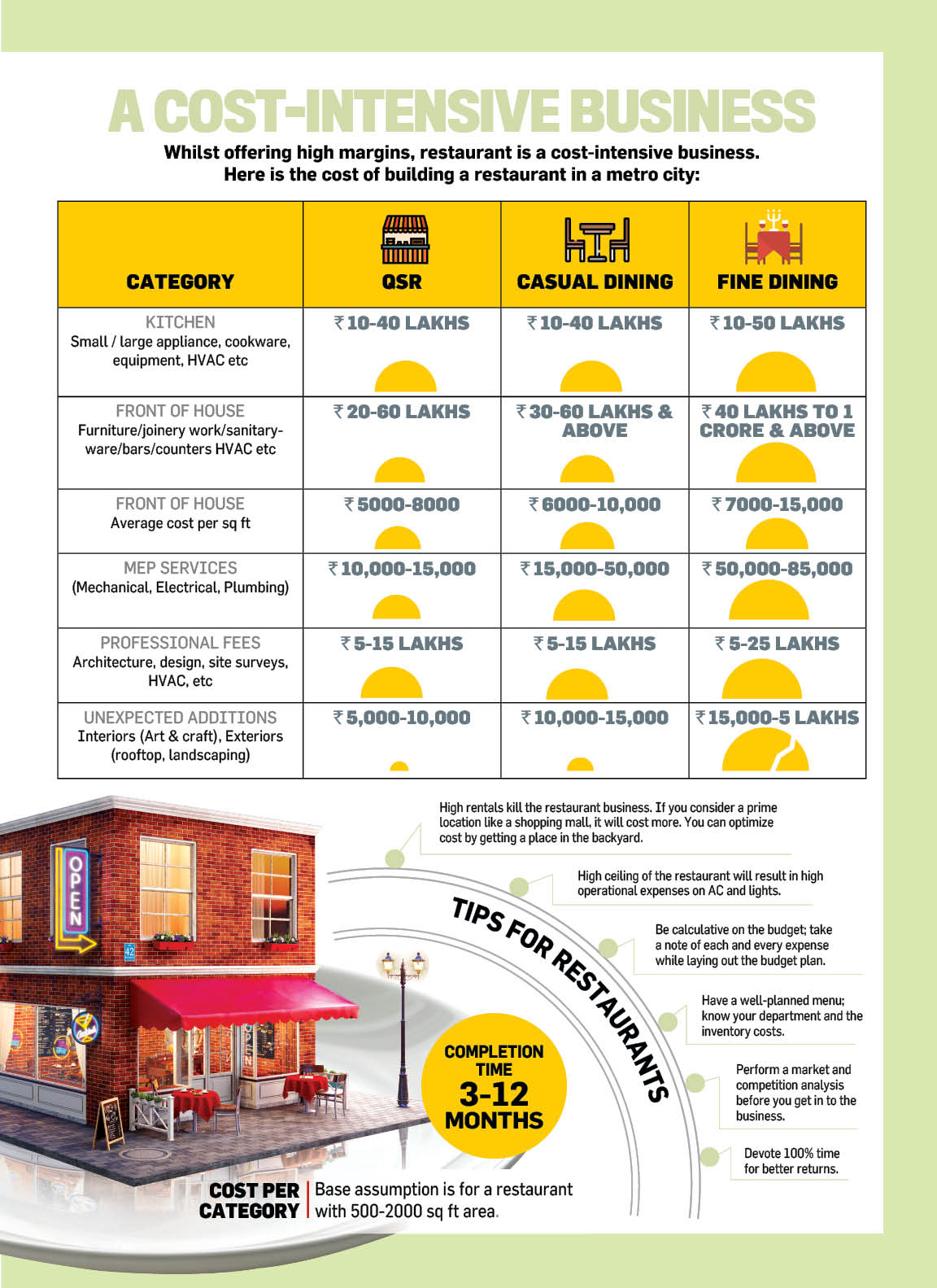
Selecting a Location
Location plays an important role in contributing to the growth of a restaurant, be it QSR, casual, or fine dining. If you are new to the industry, you may want to consider the following locations for your business: shopping centres or malls, heritage buildings, or local, smaller areas.
Shopping centres
Shopping centres or malls only because of the restaurant and the service it offers. Nilesh Limaye, founder of ABC (All Bout Cooking) says, "I know some of the shopping centres which didn't have a good footfall but they were known just because of the restaurant. People go to shopping malls so that they can choose from the various restaurant options available." The product, i.e., the food served at your restaurant, must do the talking.
Heritage Sites
If the food is good, your restaurant will certainly get recognition to be it at a heritage site or in a shopping centre, tells Nilesh Limaye. "The location matters when all the equations come together in a correct way."
If a heritage building is at a main commercial road or a busy area, then there will be more footfall.
"There are many examples in Lower Parel where restaurants do not have good footfall because the food they serve isn't good enough," tells Nilesh Limaye.
One should look into other aspects as well, like who is the target audience for that particular location. If the heritage building is a tourist spot, then it is a must-know whether the people are backpackers or luxury-oriented. If they are backpackers, you need to go ahead with a budget restaurant, while if the visitors are more luxury-oriented, you need to plan your business concept accordingly.
Smaller Sites
If you are looking for smaller sites, the cost per sq ft may increase because the total fee will be higher.
Location's impact: "The bottom line is - if it's a restaurant, the food and service has to be good in addition to what you are bringing to the table. When it is a busy street or a popular mall, the restaurant has an edge over other places. If everything is good even smaller sites work very well," tells Nilesh Limaye.

Tips to Achieve Lower Budget of Your Restaurant
"If you are paying Rs 4 lakh as rent and get a revenue of Rs 40 lakh per month, then it's a saviour. If you are paying 4 lakh as rent and the revenue generated is around Rs 15 lakh, then you have to cut the corners," says Chef Nilesh.
- The most important killer of any restaurant is the rental. If the rentals are too high, your business might be at risk. If you consider a prime location like the main shopping mall, it will cost more, but if you try to get a place in the backyard, the cost will decrease.
- Decide on whether your staff will get the travel allowances.
- If your restaurant has a huge area and the ceiling is high then AC, lights and running costs will be high.
- To achieve a lower budget, one has to be very calculative. While drafting the budget plan, note down the cost of the capital expenditure, computers, parking, marketing, advertising, PR agency, stationery; even the minute details count.
- You must have a properly-planned menu, and you should know your department and the inventory costs.
- If it's a QSR, the takeaway packaging products get costly; you need to order them in bulk to cut costs. Be sure of what type of restaurant you want to open.
- Do a market and competition analysis before you get into the business.
- The first restaurant shouldn't be delegated to someone else; it should be looked by you only.
Conclusion:
In conclusion, understanding the cost of opening a restaurant in India involves careful consideration of various factors. From restaurant construction costs per square foot to initial investment expenses, such as equipment, permits, and staffing, the financial outlay can vary significantly. Market dynamics in metro cities further influence these costs, with factors like location, competition, and consumer preferences playing pivotal roles. While there's no one-size-fits-all answer to how much it costs to build a restaurant in India, meticulous planning, budgeting, and strategic decision-making are crucial for ensuring a successful and sustainable venture in the dynamic foodservice industry.

After running RSVP at The Royal Plaza Hotel for long years successfully, New Delhi-based business baron Kabir Talwar is all set to explore new opportunities in the Food and Beverage (F&B) industry. Kabir Talwar is currently running the Delhi’s top-notch clubs and restaurants like Jazbaa and Playboy at Samrat Hotel under his firm Fit Fresh Food (India).
Talking about Fit Fresh Food's expansion plans, Kabir Talwar says, "The combination of partying and dining is a delightful experience. So Fit Fresh Food (India) is coming up with new more thrilling clubs and restaurants in New Delhi and Aerocity that will exude a warm and zestful ambience with an enticing variety of food and beverages".
Business baron Kabir Talwar tells Restaurant India about the expansion plans of Fit Fresh Food (India).
What Makes Fit Fresh Food Stand Out?
Fit Fresh Food offers a complete dining and lounging experience and is dedicated to offering a premium experimental dining experience to its clientele. In this new era of fitness consciousness, we offer people healthy-eating options which are our major plus point.
What challenges do you see in growing Fit Fresh Food?
Navigating a business is extra tricky these days. The speed of economic and technological changes means that the right path yesterday may not work today and could be a disaster by tomorrow. Solving these dynamic problems is what separates those who excel from the companies who are closing the doors. And we are constantly working to overcome these challenges and serve our best.
What is your expansion plan growing your brand further?
I've always been interested in the F&B and Entertainment business. I'm definitely looking forward to expanding my brand further. It'll be public as and when a decision is taken.
Also Read: Right Music And Safe Environment Is Crucial For Nightclubs
What have been the highs and lows of your entrepreneurial journey?
I entered the business with little or no knowledge but today when I look back, I feel I've evolved a lot through the continuous process of failing, learning and performing at my best. In my opinion, there are no highs or lows; there are just lessons and their fruits.
How was the year 2018 for you in terms of achievements, overcoming major obstacles and treading a new path?
The past year has been one of the most phenomenal years in terms of everything, I've achieved a lot, overcome some obstacles and traded various paths, but overall I've learnt a lot. In my opinion, that's most important - to go through everything and learn from it. So in a nutshell, 2018 has been a year of great learning.
What's your next trigger of growth?
I've always believed in researching what is trending at the moment and at the same time looking for fresh and unique ways to take my business further. I'm continuously working on developing new ideas to bring something eccentric both in terms of food and lounging. My next trigger would be to upgrade and reinvent these two. And conceptualize amazing offers and deals for my clientele.
What does the road to profitability look like?
Well, no success has ever come without hard work. I'd like to say it's always your hard work, patience and determination that pays you at the end so the road to probability is purely dependent on the inputs I am putting in right now.

There comes a stage in business where every entrepreneur needs to take a stand whether to expand the business and meet its potential growth. A business can only upscale and grow if the right decisions are taken, at the right time. The entrepreneur needs to ensure that the business operations and sustainability are stable, before they plan the next phase of expansion.
While there are numerous benefits, you can get from the expansion of your business, you need to do thorough research and planning before up scaling. The most essential thing before implementing an expansion plan for your business is to have an adequate bandwidth and funds. In case the expansion does not turn out the way it was planned, towards profitable growth, at least, you have contingency and bandwidth funds as a backup for sustainability of the business.
The business is worthy of doing only when there is an upward growth and brings value and excitement to the entrepreneur and his team members. There are various aspects involved in the successful expansion of the business. Yellow Tie Hospitality has adopted 4 easy steps to upscale their restaurant business using Franchising as a pivotal tool.
Business should be able to add Value: The first point you need to consider for successful business expansion is that the plans for up scaling the business should add value to the business for upward growth. If a business does not add any incremental value and surges excitement for expansion and growth in the entrepreneur, the up scaling efforts are futile. Yellow tie was successfully launched in 2015 and with the major strategies to make a mark in the hospitality industry. It focused on bringing international brands to India, and developed its own brand. It was led by a passionate leader and this growth has brought more than 55 operational outlets in its pipeline.
ALSO READ: Yellow Tie Hospitality Is Changing The Way Restaurant Brands Can Scale & Sustain
Team Effort makes all the difference: The second thing you need to consider for successful expansion is that the core team of the company and the leader needs to be at par with each other in terms of passion and dedication to the business. Business is all about good relations and teamwork with your vendors, suppliers, and team members. The collaboration of teamwork is the most essential for successful business growth and expansion. Yellow Tie Hospitality has truly reflected strong teamwork. The team strength of the Yellow Tie has grown from 3 to 70 in the past three years. Young leaders have taken charge of multiple roles with diversifies responsibilities to implement aggressive growth plans. “The idea to offer entrepreneurs readymade restaurant concept that can be scaled up and managed with ease”, believes Karan Tanna, a 31-year-old Founder and CEO of the Company.
MUST READ: How Training Helps Build A Healthy Restaurant Culture
Going in the right direction: Karan Tanna focused on spending his precious time in the right direction. Be it any kind of business, the entrepreneur focused and dedicated his time to the right aspect of the business for increased efficiency, which set the groundwork for successful expansion. If the entrepreneur does not put up the right efforts at the right places, a business will never grow. The art of delegating responsibilities to the team members, adding the right values to the business and hitting the right chord in every business decision is crucial to achieve sustainability and growth. A hasty decision without proper analysis and discussion with the team members for an expansion of the business can backfire, most of the times.
Business Networking & Building Relationships: When Karan Tanna started Yellow Tie Hospitality, he travelled to various franchises to build friendly relations to expand business. The start-up earned investors by the way of successful testimonials. The company worked hard to ensure that the outlets that partnered with them initially achieved decent returns on their investment. Today, it has an analytical team to manage the PR & Networking at the right forums for the company. It has successfully partnered with 200+ entrepreneurs in just a year and it continues to succeed progressively. YTH has brought the Genuine Boaster Chicken franchise in India in the year 2016 and also partnered with celebrity Chef Harpal Singh Sokhi to start up Dhadoom, Twist Of Tadka & BB Jaan. Managing the logistics and the supply chain was among the toughest challenges that Karan Tanna had to overcome.
MAY INTEREST: How Top Restaurants Are Keeping Design Minimal
With the successful implementation of the business strategies for successful growth and expansion of the business, and sheer hard work and dedication from Tanna and his team has led to YTH success and successful upscale for the value of the brand. YTH has various achievements under its belt in a short span of time. YTH brand 'Dhadoom’ has been awarded India's Top 100 Franchise 2019, 'Wrapchic’ has won Best Debutant Quick Service Restaurant award in 2018, 'Genuine Broaster Chicken’ has been awarded as the Best American Style Diner in 2017. The brand had also won the Best Debutant Chain award in 2016 when it witnessed a whopping revenue of 1 Crore in its very first financial year.
Tanna says that he plans to upscale and expand Yellow Tie Hospitality but he understands that YTH is “limited by our bandwidth”. He also believes that this will soon change and growth is surely on the cards in the near future.

Corporate Master Chef (Indian Cuisine) at Hotel Leela Kempinski, Chef Farman Ali has established himself as a pioneer of fine Indian cuisine. He has been involved in the openings of the famous Indian restaurants - The Jamavar at Bengaluru and reopening of Jamavar in Mumbai, Delhi Ka Aangan at the Hyatt Regency Delhi, Darshan at Radisson SAS, Jumeira Beach Dubai, Indian Show Kitchen at Hyatt Regency Dubai and Indian Kitchen at Grand Hyatt Dubai.
Chef Farman Ali is a native of Old Delhi. His professional career started as a kitchen trainee in tandoor at the President Hotel in New Delhi. He then worked at The Oberoi Intercontinental for nine years, climbing up the hierarchy as senior chef de partie. He, later, joined Hyatt Regency and was the part of the opening team of Delhi ki Aangan.
Joining Delhi ka Aangan, gave him an opportunity to go overseas. He took up the role of Indian Chef at the Hyatt Regency Dubai for a period of five years.

In an interview with Restaurant India, Corporate Master Chef Farman Ali speaks why people prefer eating authentic dishes at hotel restaurants as compared to standalones.
50 Years in the Industry
I came back to India as Chef de Cuisine at the same restaurant which I had earlier opened for about two years before I moved to Le Meridian Abu Dhabi as Indian chef for four years. A very important point of my career has been joining The Leela Ventures of which I have been part for the past 17 years. I have been featured as the Star Chef for Lufthansa for the period between 2009 to 2011 and again between 2011-2013 where my menus were served to the First class and business-class passengers.
I am, presently, the Corporate Master Indian Chef for Leela Palaces and resorts and based out of The Leela Palace Bengaluru with an overall experience of 50 years in the Hotel Industry as Indian Chef.
Also Read: Chefs Must Take The Lead To Develop Restaurant Businesses In India
People are on the Lookout for Traditional and Authentic Cuisines Now
All the transitions we see today are a result of the awareness brought about by social media and other important sources. The last decade has seen a lot of changes with a previous couple of years being the peak. As much as there has been an urge to try out new cuisines, new preparations, there has also been a steep rise in people looking out for traditional and authentic preparations from different regions. Awareness about the ill-effects of junk and ready-to-eat foods have seen a rise and people have become more health-conscious and look out for more healthier options in food, and believe to keep it simple.
Signature Dishes
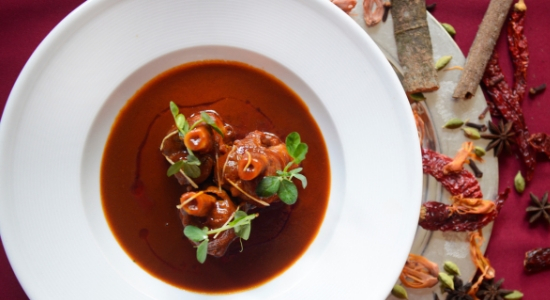
Rogan Josh
Over the years there have been many of my preparations which have stood out well and have been made signatures of the particular place. At present some of my signature dishes at Jamavar are Gosht Chaamp Tajdar, Jheenga Sultani, Murgh Abeer, Paneer Tikka Badshahi and Palak Benazir amongst the appetizers and Nalli ka Salan, Gosht Nihari, Murgh Makhni, Murgh Alamgir, Gucchi mutter Masala and Paneer kadhai Masala amongst the main course.
Key Challenges at Restaurants
A major challenge faced often is to do with the specific requirements owing to health and religious conditions which refrain people from certain ingredients; these ingredients are probably the hero in a particular dish.
Another challenge is to ensure the right flavour and balance of that particular cuisine when you are not using the above-said ingredient.
As chefs, we evolve and learn new things every single day and often use our expertise to overcome such challenges in our day-to-day operations.
Keeping the Authentic Flavors Intact
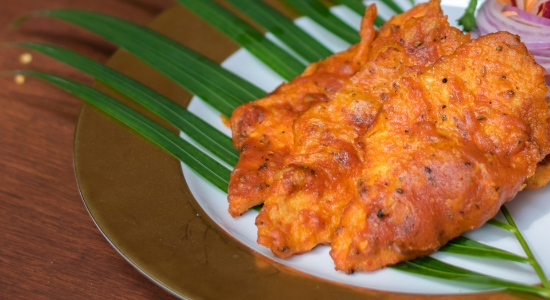
Kokur De Pakore
Being part of the Industry for over 50 years now, I have good exposure. The key to ensuring authenticity is to be able to procure the right ingredients. Another factor is to train the team and make them understand the complete process - all the whys and hows - rather than just asking them to follow a recipe. Periodic refresher training and food festivals conducted often help us ensure authenticity.
Hotel vs. Standalone restaurants in India: The Consumption Pattern
Standalone restaurants have cropped up in huge numbers in all parts of the country and are creating new trends from time to time. There is a lot of innovation that can be seen in such places but in due course, the authenticity of cuisine often takes backstage. The true flavours and nature of dishes are often morphed up with fusion.
Restaurants in Hotels like Jamavar, the Indian Specialty restaurant at The Leela Palace, serve authentic dishes with all the ingredients sourced from the places where the dishes belong to. Having mentioned this, every place has its clientele. Guests who prefer authentic dishes would still prefer hotels than standalones.
Serving Kashmiri Food
In every region, the food habits are based on the culture, tradition, climatic condition and availability of the local produce. People in Kashmir use such ingredients that could provide heat to the body, due to the climatic conditions there. The use of meat in the diet is high considering a cold climate. Most of the dishes are slow-cooked and rich in nature. Use of yogurt, saffron and nuts make the dishes rich.
Lamb is the most predominant meat in use followed by chicken. Beef and pork are seldom consumed owing to religious and availability reasons. Spices of a nature that suits well to the climate include cinnamon, cardamom, cloves, fennel, saffron and dry ginger powder. Vegetables include kohlrabi, turnips, lotus root which grows abundantly in the Valley through all other vegetables can be sourced out.
Organising Authentic Food Fests Affect the Businesses
Periodic food festivals, organized by restaurants, help in many aspects. It breaks the monotony of having a similar menu for long periods of time. It is an occasion to showcase our skills and abilities along with the team of chefs whom we invite from our sister properties to create authentic menus from the region which we want to showcase. It is a great opportunity for us to train our teams with authentic preparations from a particular region which by itself is a motivation to our staff; this also helps in staff retention. In the process of organizing these festivals we also get to learn about new ingredients which we specifically get for the event. Most importantly we give our guests an opportunity to try authentic dishes from a particular region of our country.

Virtual Reality can change the food experience; today food industry is on the forefront of innovation generating $700 billion annually. Also, it is the industry providing employment to one out of ten people according to the National Restaurant Association. Hospitality sector builds confidence, leadership skills, and excellent problem solving skills. Food service management is a job where about 40% of those working in a management capacity are self-employed. But the success of this business depends upon how well the marketing part is played. We can witness the competition in this industry and digitalization has made it even more competitive. An excellent customer review could do wonders and a single critic could impact the restaurant business.
As we are never tired of saying, food service experience starts from dining to satiate the palates giving the customers an alluring ambience as well. It is a work of team to build a business not a one man thing and that is why digitalization also affects food sector in a tremendous way. A study from Brick Meets Clicks showed that e-commerce is important for grocery retailers now and will grow into the future. About 4 percent of U.S. grocery sales, or $27 billion, was through e-commerce in 2014. By 2023, e-commerce could account for up to 17 percent of grocery sales, according to the researchers which speaks the volume in itself.
Here are few ways how digital marketing could help growing the business.
Knowledge Opens the Door
Do your homework properly; do research about the market, trend, industry, competitors and consumers. You would be ready to take it on face if you’re prepared to the fullest. Just keep your eyes and ears open and hunt the opportunity down. History has proved that there are numerous owners who have started their careers from stacking or washing dishes; they made their way from an entry level position because in food service sector totally depends up on the knowledge and skills of the business. But who would have known about their struggle without media or digitalization? Therefore it is important to know where they should market or publicize to get their product in consumers’ knowledge. Tattooing their brand in people’s mind would take a little time but it’s worth it because digitalization could even do wonders in a single night. They just need to have the knowledge of industry, management and how to sell their product and obviously their passion and love for the industry would play the foremost role.
Experiment is the key to success
As food industry is up for innovations and experiments these days; building new theories and new trends are the new words for this industry. And, the work has not finished yet, now they need to post their experiment every where possible, to make it digital and in people’s knowledge. Once, something is on net it’s everywhere then. Key is to find the niche and experiment with that. Give customers something to relate i.e.’ cuisine, service, quality or ambience and make strategy according to that.
Keep the crowd coming back
Engaging your crowd is one of the hardest deeds in the hospitality sector. Keep pitching your products, interact with them, and do offer those discounts or schemes like that. Make videos, take reviews, freebies- interaction and engagement is there for the taking.
Post your food
Blogging and posting about food has become the new trend. It creates traffic which led to an imprint in people’s mind. It is a stupendous way to engage customers and that would also help you to feed the social media content. This will also keep your crowd coming back and also could connect you to the other foodies, food bloggers and vloggers to you; they are the ones keep posting about food. They could be a great medium to promote your food among people.
Invest at right place
You must look out where you’re investing. Investing in good food satiate the palates same as investing in the right direction satiates the business. Therefore, financing is an important part. Restaurateurs could also hire someone to watch over all the marketing part.
Hospitality business seems glorious but at the same time is difficult to handle. It requires hard work, a lot of responsibilities and passion for the industry to keep working. Just enjoying the work and then following right direction is enough.

Restaurant owners can get their business to new heights, introduce new dishes on their menus and win customers loyalty by starting a restaurant blog for their business. Whether they are a new player or have been in this business for several years, owners might find it beneficial to start a blog.
Many of the most successful businesses are known as industry leaders because they educate others in their fields. You can use a blog to help educate other restaurants in your industry and be known as a leader in your industry this way.
Blog enthusiasts or bloggers have started blogs about and on food industry or Chefs, yet most of the restaurant websites skip this step. With blogging becoming a fad and a popular choice for readers, restaurants should be asking: Why aren’t we getting involved?
One of the main reasons restaurants probably ignore the blogging phenomenon is because they don’t understand how it can help boost their business. Although consumers initially go to a restaurant’s website for the menu, a blog is a great and added feature. Blogs create an image in the consumers mind even before the food is ordered or liked.
Use it in Your Favor
You can educate your audience about the aspects of the restaurant industry or your restaurant in person, including the details about the range of food in your restaurant or the genre or category of food you specialise in.
You can also give a sneak peak about the future plans of the restaurant and on parallel terms promote it too!
You can even describe the on-going events and offers in your restaurant and can reason out why it should not be missed at any cost.
The most important standpoint of blogging can be “Guest blogging” (having someone outside your company submit articles to your blog) – a crowd-pleasing and a way to earn back-links. It can act to your advantage as you can connect with your customers and get their feedback about your restaurant as well. Since their blogs will be on your website, people will be excited to recommend your website and your networking will only improve.
While there are countless ways to market your restaurant, restaurant blogging outweighs most methods. The best part about a blog is the notion that you don’t have to add content every day. Even if you update the blog once or twice every month you can still earn the benefits from it.
Go blogging and stay connected!

While making juices at home Anuj Rakyan thought of establishing a healthier option than homemade juices as well as tetra packed juices. Talking about his brand Anuj said,” Using his learnings about food and nutrition, Rakyan created Raw Pressery, a company which has grown 120% in FY18.
In conversation with Restaurant India at TIE Food Summit 2018, Anuj Rakyan, Raw Pressery talks about the unorganized beverage industry and how emerging brands should bring in major changes in comparison to the older ones.
Tell us about your Journey.
We have created a category of fresh beverages which was very important because consumers were in search for it. In terms of my professional journey, creating a market and giving consumers what they want has been very fulfilling. Raw Pressery Juices are made with a unique cold pressed technology that avoids oxidation and preserves the nutritional value of fruits and vegetables.
With such a refreshing concept, how do you plan to scale this business?
Fresh juices have always existed in India except the fact that they were always made at home or brought on the streets or juice centers. We are planning to organise the unorganized market for fresh beverages. In many ways, we are doing something new. In many ways we are doing something that was already there. We have already made our mark in 12 cities with a presence in more than hundred’s of stores. The next few years will be focused on enhancing the brand, quality and increasing the distribution.
How do you plan to bring advancements in the beverage industry?
We want to continue giving people which will be convenient for them to consume, but convenience without compromise by remaining functional, nutritious and healthy.
Where are we missing out in the F&B industry today?
The FMCG companies and retailers in the past were only focusing on low quality products that they can make at a very low price and distribute as much as they could. Time has changed and more retailers are focusing on having products by increasing the refrigerated areas within their stores, young emerging companies are now challenging the big companies to make healthier products, well packaged and nicely branded.
India has a supply chain for chilled and fresh beverages which is quite expensive. In terms of challenge, the supply chains need to develop and completely change the ongoing scenario.

When thinking of a restaurant you often consciously think of the menu. Is the food, however, enough to create repeat business from a customer? While some will argue yes, the majority will know that there is more to the dining experience than just the food. It's also the interior design of the restaurant that influences repeat customers.
Celebrity Mixologist Arijit Bose, when asked about the design of full service restaurants said,” It can make or break your dining experience. The inside of the bar has gained much prominence in the past few years.”
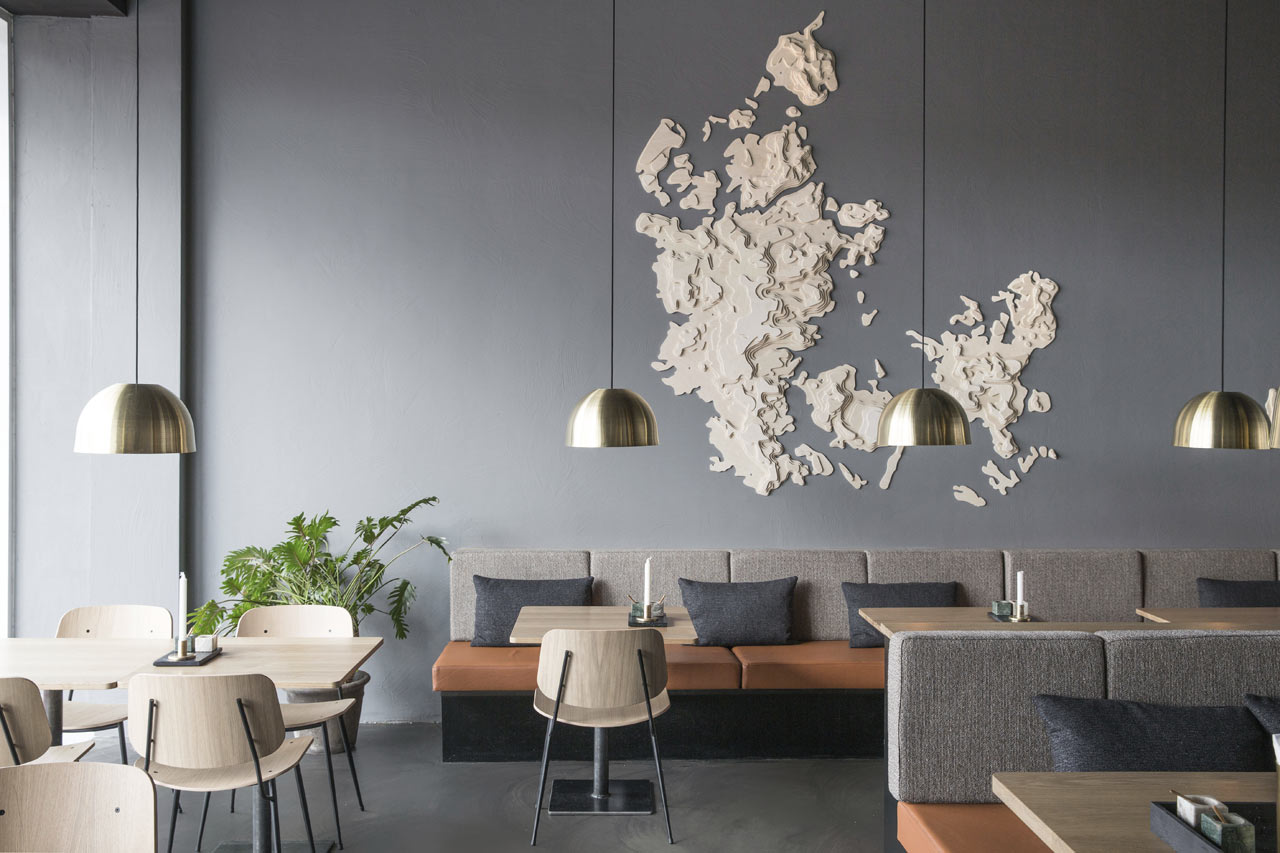
Play it Well With Furniture’s
Since the online home décor and furniture market is no longer a niche segment, differentiation and a competitive edge are imperative. Keeping this in mind, Natasha started Bent Chair in Delhi in August 2016. From the shape and squashiness of dining chairs to the exact textures of the wallpaper, Natasha reveals,” It takes a lot of knowledge that goes into creating the interior of a restaurant.”
A well structured dining room is more than just tables & chairs. It sets the tone and ambiance of your restaurant. Creating an amazing interior design is anything but simple. There are thousands of factors to juggle ranging from your restaurant, bar or cafe’s style, to making the interior as beautiful and decorative as possible without disrupting the staff’s workflow.
Commenting on the same, Natasha said,” It’s not how the equipment looks but how it is wired.”
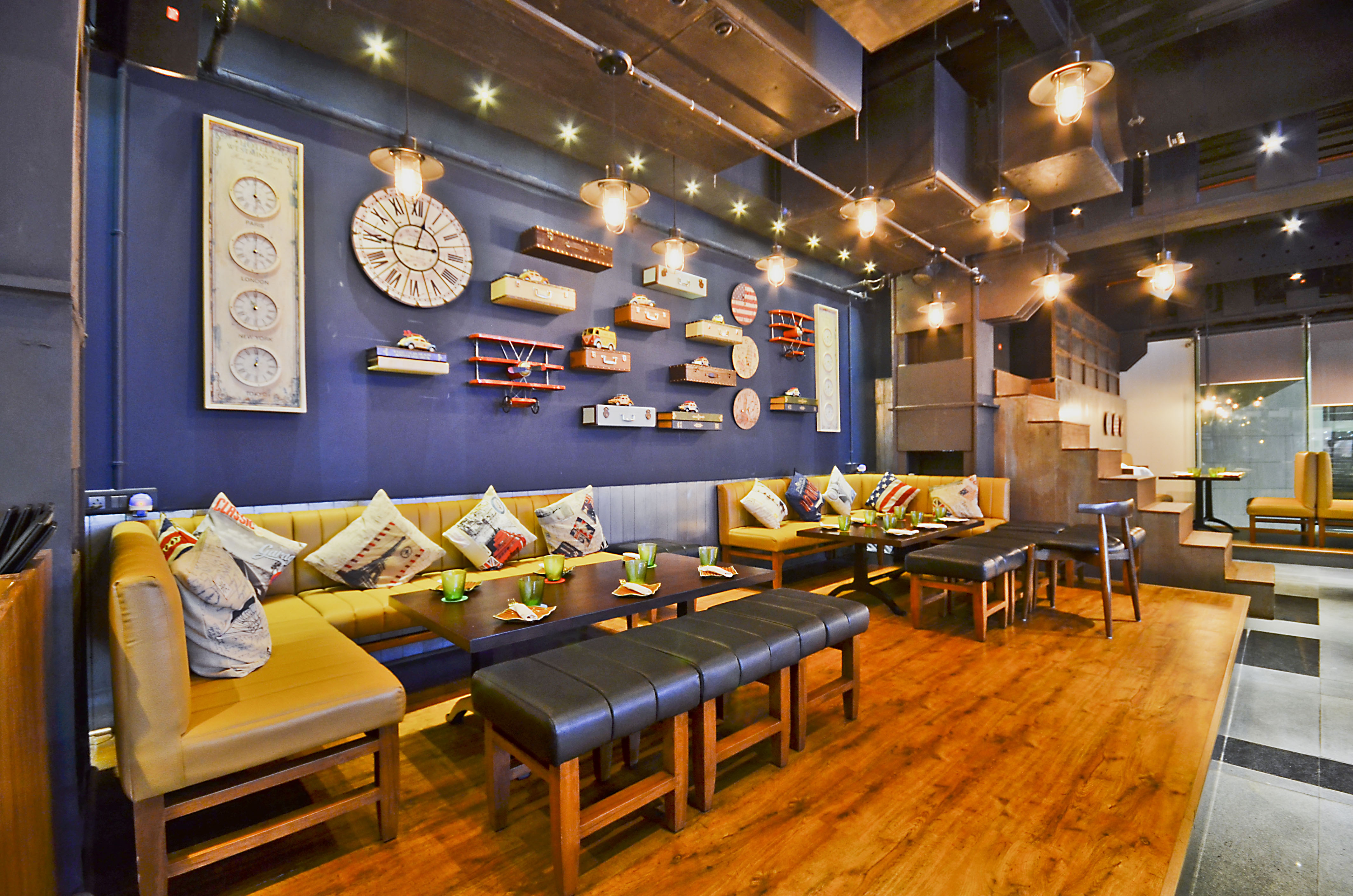
The Tricks & Actions
From a psychological point of view, one of the key aspects to a restaurant’s design is the lighting. It has to be soft and flattering to make guests feel comfortable so that they are confident and relaxed and enjoy their stay in the restaurant.
“We tend to do this through soft ambient lighting to complement the more targeted architectural lighting and also to suit the time of day. In my experience, the worst lighting is when there are just down lights over the tables that can cast shadows over diners face. This can be very unflattering for guests and make them feel uncomfortable”, said Arijit Bose.
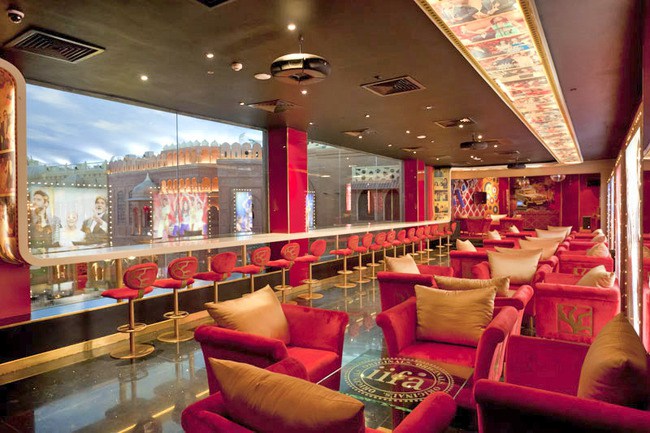
What Makes a Great Restaurant or Bar
It is all down to good planning of the place and making it work, something that customers would not be aware of. Then it is about atmosphere, from lighting to music. People have to feel relaxed, but before we start on a project we research extensively into the offer and the location, making sure that what we are designing is relevant to the local or targeted demographic
When asked about to what she attributes her designing skills, Natasha said,” Education, Travelling and Learning from outside have helped me broaden my knowledge space about interior decors.”
The ongoing trend has completely tilted towards eating and drinking out and thus restaurants and bar owners is trying really hard to make it a holistic experience for their customers.

In today’s time, every restaurant or a restaurateur wants to live up to the customer’s expectation by fulfilling their demands and making their visit a memorable one. Businesses have grown; some flourished while others have deteriorated with time.
“The nine year journey in the ever-growing and evolving F&B business has been very exciting”, says Inderjeet Singh Banga, who runs 3 Operational Brands namely Pirates of Grill, Prankster and the newest baby to their portfolio is Pra Pra Prank, a mysteriously named eatery at the DLF Cyber Hub, Gurgaon.
In conversation with Restaurant India, Banga shares the exciting journey of being in the business, running it successfully and taking it further through the franchising route.
Choosing the Right Business Model
“It’s a great opportunity to put your brand in newer places, meet people with similar mindsets, and together create a cohesive synergy between our thought patterns and their expectations out of a brand thus make the business grow”, says Inderjeet Singh Banga.
Giving an insight about his ventures, Banga said,” We have 3 franchised outlets at the moment which runs on a franchise model of FOCO. We are very particular with the brands that we operate and think our brands have a benchmark value for which we would not want to dilute the experience of the consumer.”
Balancing it Out
A brand is nothing but an intrinsic experience. Making your brand a process driven or a people driven organization is always worth enough.
As far as customer experience and customer satisfaction is concerned, Banga shares his plan to make this business more profitable and a sustainable one. He says,” When you work for your consumer that’s when you cross the first hurdle. Secondly, whatever experience you create it has to be given at multiple locations.”
The Roller Coaster Ride
Restaurant brands today are witnessing a roller coaster ride in today’s consumer environment. “From finding the right location to having found the mindset of people, to the government policies, to the intense competition and to the evolvement of Indian consumers, everyday can be a challenge for you when you are in the business”, says Banga.
From shifting customer preferences and expectations, the standards have been set very high with a sophisticated view on food and beverages.
Banga says,” You always have to be on the edge and it is only possible when you have a team who can do the right things for you. Only then your love for the work takes the front stage and the challenges take the backstage.”

With so many changes taking place in both the Restaurant industry and the region at large, Indian Restaurant Congress 2018 has set a benchmark for empowering the Restaurant and Food service sector.
Indian Restaurant Congress 2018 captured the four facets that will move the cheese for the industry from Good to Great including; Innovation, Experience and Scale and most Importantly a strong Business Culture that creates successful and sustainable restaurant enterprise.
The day one of the congress focused on building and nurturing the business of food and the innovation ecosystem for supporting entrepreneurs and creating platforms for collaboration. It is the platform where restaurants, chefs, brands found future business models, menus and Ideas to address tomorrow’s market demand.
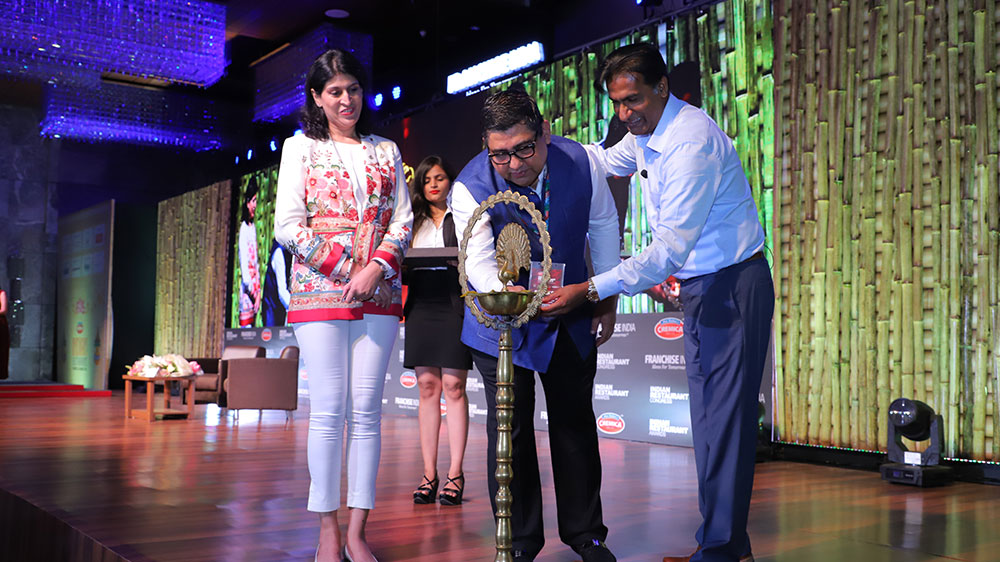
The Congress was kick started with the inaugural session led by Rajeev Varman, CEO, Burger King India; Anjan Chatterjee, Founder, Speciality Restaurants along with Ritu Marya, Editor-in-Chief, Franchise India Group signifying an auspicious start to the proceedings.
Some of the other leading thought leaders at the conference included Unnat Varma, MD, Pizza Hut (India); Ashish Saxena, Tex Mex Cuisines(Chili’s Restaurants); Ashish Kapur, Founder, Moods Hospitality(Whisky Sambha); Jaspal Sabharwal, Senior Director, Everstone Capital & Co-Founder TagTaste Foods; Rajat Tuli, Principal, AT Kearney; Anand Thakur, Chief Digital Officer, Jubilant Foodworks; Chef Nishant Choubey, Corporate chef, Roseate House; Sahil Jain, Co-Founder, Dineout amongst others.
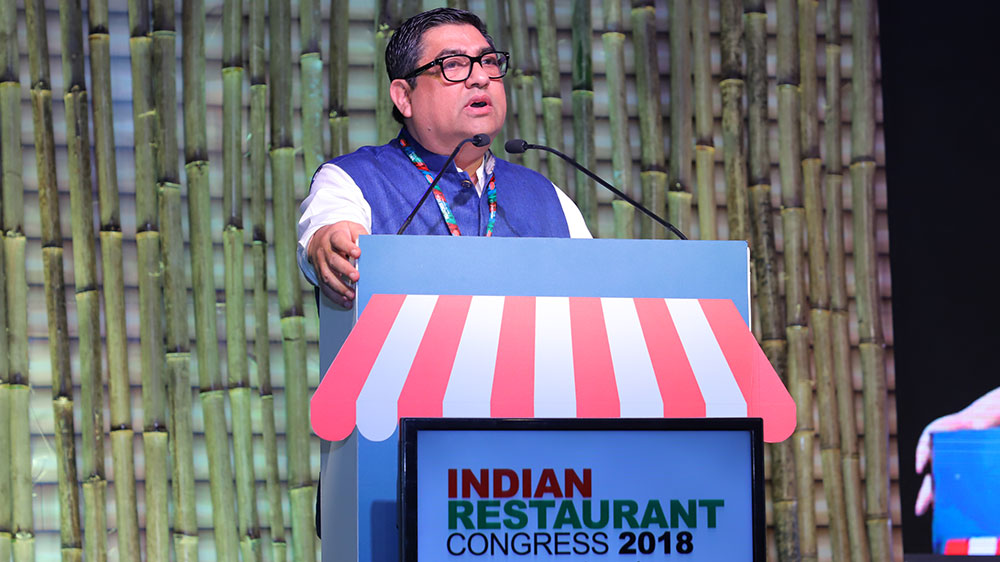
The inaugural session was about The Business of Restaurants: Predicting Tomorrow, Today. The session was mainly concerned about the state of the Indian Foodservice Industry which led to a discussion on Leaders Viewpoint and Expectations on Innovation, Experience & Scale.
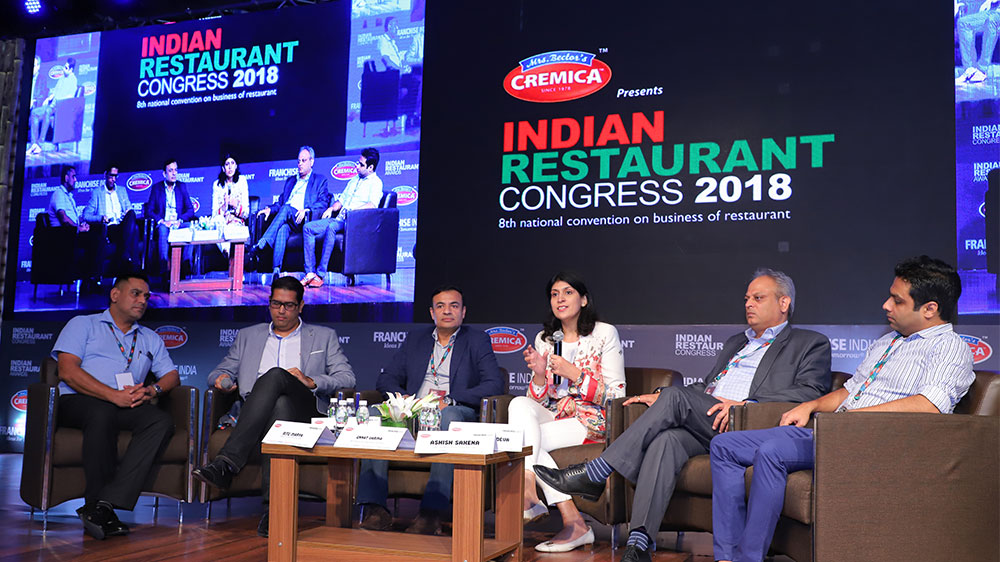
Global brands have always stayed at the top when introducing newness into the Restaurant Business. The next session talked about what innovation meant for Global Brands. The session was led & moderated by Ritu Marya, Editor-in-chief, Franchise India, Unnat Varma, MD, Pizza Hut India Sub Continent; Ashish Saxena, CEO, TexMex Cuisine India Pvt. Ltd; Sharad Sachdeva, CEO, Lite Bite Foods; Sahil Jain, Co-founder, Dineout; Chef Sumant Vikas, Corporate Chef, Cremica Food Industries Ltd.
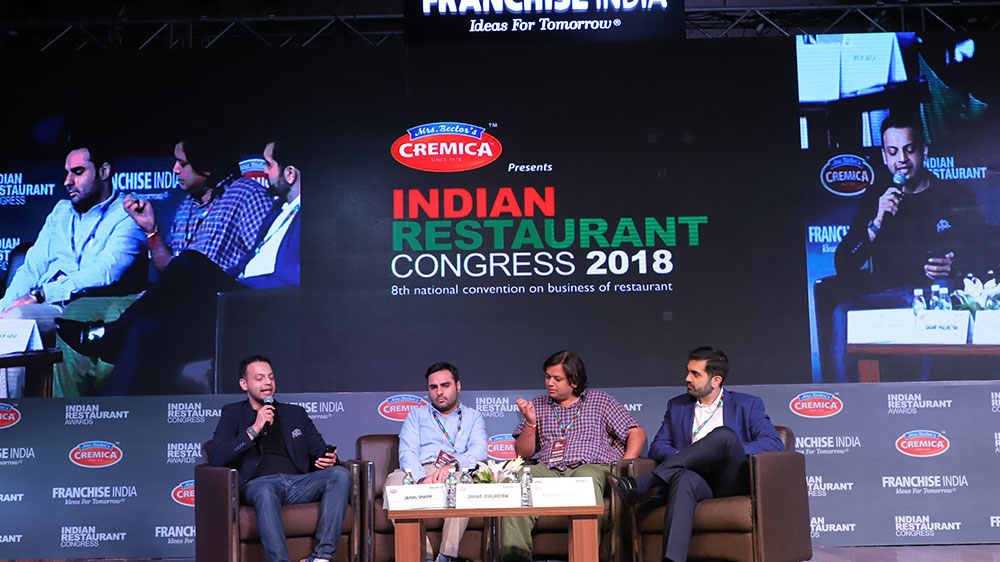
The first half of the Conference witnessed several panel sessions with speakers like Jaspal Singh Sabharwal, Co-Founder & CEO-TagTaste & Senior Director-Everstone Capital; Pavan Jambagi, Founder & Director, Carnatic Café; Varun Kapur, ED, K Hospitality Corp; Savar Malhotra, Managing Partner, The Embassy Restaurant who addressed the conference and enlightened the audiences with their golden words.
On the second half of the conference, there was a panel session on the ongoing top techniques & tools for controlling Manpower costs, new age customers, supply chain issues and technology at the larger extent.
The evening was welcomed with CIGAR & BAR SUMMIT, where the stage was set for the leading lounge, bar, and nightclub owners who rose a toast for unlocking the opportunities and the next big bar and Lounge trends in the market.
The day two of the conference was more focused on delivering expereince in the restaurant bsuiness here top chefs and restaurant owners discussed and debated on topics like growing home chef culture, food truck business, new catering opportunities to name a few.
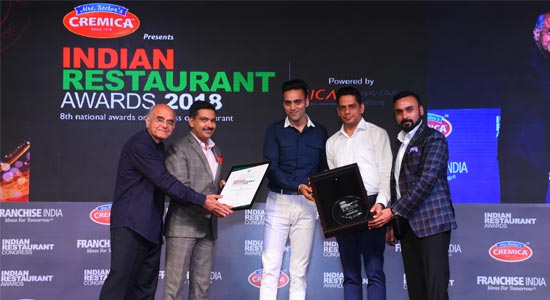
Adding glitz to the glamour was the Indian Restaurant Awards 2018 that also celebrated and honoured victory of chefs and restaurateurs who have made a difference in the restaurant business with their offerings by staying ahead of the curve. The Indian Restaurant Awards also welcomed famous cricketer and 34 year old Delhi boy Mr. Amit Mishra who has a record of 1000 wickets in first class cricket. He is the only Indian Cricketer who has taken 3 hat-tricks in Indian Premier League and is the highest wicket taker in IPL; Thought Leader and Author, Mr. Gurcharan Das; INC Spokesperson Prof. Dr. Gourav Vallabh as some of the top dignitaries to present awards to the top winners.

Today, businesses are highly aware of the value of social media data, and the importance of communicating with their audiences. Social media has not only proved its ability to produce tangible results but has also demonstrated the capacity to develop strong contact points between brands and their customers and improve customer experience.
Social media is everywhere and is vastly expanding - but what effect do the various social platforms have on a company's brand awareness, engagement, revenue, and sales?
Use it Wisely
You cannot ignore the power of social media within the restaurant industry. In fact, it could easily be said that if you are not online you are more or less trying to communicate with your guests with two tin cans bound with a piece of string. Now being old-school might be cool, that is just a little too out of date.
80% of the people will look at a restaurant online prior to visiting for the first time. This means it will check out a restaurant website and browse through online reviews.
Vasudevan Cheruvulli, Owner, Pan India Foods say,” Social media is an inevitable part of running a modern business. Whether your business is active on social media or not, you can be sure that your guests are tweeting, posting, and Instagramming about your restaurant online. Billions of people use social media. This is not a fad, and it's not something that can just be used by individuals to communicate. Social media now has an immense presence in conducting business, especially for restaurants.”
Research has it that 75% of people who browse food photos say they have chosen a place to eat based on social media. That means by just simply posting a photo of your food, you could be bringing in your next customer.
From the cost-effectiveness point of view, Virat Kapoor, Owner, The Sammy Sosa says,” The concept of pay per click enables businesses or business owners to actually determine the effectiveness of a campaign which was not possible through other forms of advertisements.”
Stressing it further Vasudevan says,” Today, more people are eating in restaurants than ever before. Diners love to research their options on Google and look at their social media sites before choosing a location.”
Food Products Going Viral
The KFC Double Down is a perfect example of this effect. When chain restaurants rolled out new items in the past, they were confined to a small market and the impact of the item was only local. This meant that a new sandwich could create a local buzz, but not much more.
The Double Down was similarly released in a small market, but the presence of social media caused it to become a national topic. Even though a lot of this publicity was necessary, it still got people talking about the KFC brand. Similar effects have been seen at the chain Hardees.
Because of instances like this, analysts have predicted that companies will make even more outrageous products.
Transparency in Business
Online review sites and social media have transformed restaurant marketing from word-of-mouth to world-of-mouth. In just click of a button, we can share a photo of our favorite dessert with the world. That has power. You need to respect and harness that power in order to build your brand.
Vasudevan shares three unique ways of utilizing social media for the business.
- Respond to Online Reviews:By addressing negative reviews and showing appreciation for positive ones, the brand can create a transparent and friendly persona online. It should not be afraid to talk about its flaws and make a public attempt to improve upon them.
- Share Customer- Generated Content: Brands can their customers into valuable brand ambassadors by sharing their comments and photos on the same social media. By acknowledging these posts and encouraging them the Brand can create social proof for itself and hence generate a backlog of social media content.
- Ask Questions to Engage Followers:Social media is about more than just telling your followers what's happening at your restaurant. It's also about listening to them. Platforms like Facebook, Twitter, and Instagram are a great way to create a two-way dialogue with your customers.
Commenting on its use, Vimal Verma, Director, Andaz, says,” It totally depends on your target customer and their behaviours and once it is known then the suitable medium can be used to make it effective and relevant.”
Social media pages are a great way to establish transparency. Guests should always be encouraged to leave reviews and post pictures about their experience at your restaurant.
Social media pages are a great way to establish transparency. Guests should always be encouraged to leave reviews and post pictures about their experience at your restaurant.
Scaling Profits
Everyone likes to share experience and likes the engagement with restaurants. More engagements would lead to more return of customers and more business. All international travellers also look for recommendations from google or tripadvisior or other mediums to see the dining options.
“Correct presence and good reviews give confidence to someone who wants to try for the first time and you can acquire a new customer”, added Verma

Sourcing ingredients are one of the top priorities for any successful food business. Choosing the right food supplier is a critical business decision, as one has to guarantee the quality, safety, and value of the food offered. It’s a restaurateur’s responsibility to cater to customer and client needs. This has to comply with government regulations and quality standards, and provide quality meals, all while keeping the budget under control. As government and industry put a stronger emphasis on food safety and quality; so, evaluating and selecting the right supplier today has become even more complex.
Manish Tandon, CEO, au bon pain & Sagar Daryani, Co-Founder, WOW MOMO spoke candidly about best practices in working with suppliers to drive brand sales and profits, as well as the importance of cutting ties and moving to other vendors when the time is right.
How do you find the best suppliers for your brands?
Your relationship with your vendor is like a marriage: you should be able to complain or argue with your best supplier, and at the end of the day, you will have hopefully corrected any problems and made up. Before you commit to a vendor, you have to shop around. Make sure that your vendor has outstanding references by asking them what restaurants they serve and contact those restaurants directly.
au bon pain- Manish Tandon says,” The process of identifying a supplier is a step by step process. Firstly, we identify the products for which we need a supplier and establish a set of product specifications. Then we ask the available/reputed suppliers to provide us with samples. Basis the product quality check and price quote, we negotiate on the price for our volume. Then our team does a vendor facility audit for quality and hygiene and cross check all legal requirements. Based on the audit report, we finalize the best vendor/supplier.”
WOW Momo- Sagar Daryani says,” What you put into the food, that’s what comes out of it. A quality product will always ensure that you have repeated customers which make your quality brand. When it comes to suppliers or raw materials, this entire ecosystem goes by the word of mouth. All our food ingredients for our packaged foods, we have one single vendor with whom we operate nationally, with a direct tie-up with the brand. We ensure that we get the required quantity in the right quality to maintain the consistency of our brand. When fresh food is concerned, we look for vendors supplying to other big chains, say the best chicken vendor in Delhi or Mumbai and accordingly we get the samples.
How does the supplier's performance ultimately impact the brand?
Your customers love your food and the service, but it’s a delicate thread that binds them to you. All it takes is one or two disappointing meals, or their favorite menu item is sold out; or, the food is not as fresh as it could be… and one day you realize that you haven’t seen that family in a while.
au bon pain- Tandon says,” Restaurant business is very unpredictable because we deal in a lot of perishable ingredients, hence supplier performance plays a very crucial role in building a brand image. Some of the key areas of supplier performance affecting the brand image are: timely delivery, quality as per desired specs, Emergency support in case of urgent requirement.”
WOW Momo- Daryani opines,” If there is marginal complacency from the suppliers, with sluggish service or problems with the delivery of the product; it hampers the entire supply chain logistics. Brands like us who are producing and selling on a daily basis, suppliers have to consistent with their efforts. Suppliers are indeed very important stakeholders in your business and with that both the brand and the supplier has to cooperate to take the game further.”
How can suppliers make or break a brand?
Your approach to suppliers needs to be part of your strategic plan since almost every company, whether product- or service-oriented, is dependent on suppliers. Many business owners seem to get this supplier issue backwards. They think that because they write the order, they're in the dominant position and can exploit it with unreasonable demands, including personal perks.
au bon pain- “Supplies are at the core of any restaurants business. If there is any compromise on the quality specifications or a delay in supplies, it can lead to significant impact on the quality of output to the customers. A single bad review on any digital media platform and word of mouth can tarnish the brand image, and this multiplies very fast. So the supplier has to adhere to quality specifications and delivery in a timely manner as agreed with the brand”, said Tandon.
WOW Momo- “Today, the entire manufacturing and production cycle can get disrupted if suppliers don’t give the products on time. You have to ensure the supplier’s performance in terms of their quality consistency and product service timings etc. with other brands from the industry. We are paying for the fresh materials and we expect the same from our suppliers. Quality assurance is our key concern when it comes to building our brand”, said Daryani.
Let's get this right--you need good and reliable suppliers!

Some of the world's most upmarket restaurant brands have taken a bite out of the India story. Unlike the multinational fast-food brands like McDonald's and KFC, which have expanded in the country over a decade with hundreds of outlets, these high-end chains want to remain exclusive.
Franchising, which is an American invention from the 1800s, is a unique business model that allows two separate owners to share in the operations and profits of a business, each providing support and resources. While franchises can serve as an entry point into business ownership for many, included in the deal is a complex set of operational protocols and assorted challenges.
For example, the nature of the operation often prevents franchise employees from unionizing, and recent lawsuits against larger chains have resulted in questions about work rights and how a franchise is defined.
Holding the Master Franchisee of SBARRO, Western India, an American brand that has over 600 stores across the world, Rashmi Balwani, Managing Director, Upper Crust Foods Pvt Ltd shares her experience in the Franchise Business. “With my learnings in the franchising world, I voyaged in the Master franchise route of bringing a brand to India, dwelling it up as our own brand with systems in place.”
Maintaining relation with franchisor & franchisee
The franchisor dares to open franchising opportunities for franchisees, only when the brand has been established. It takes a huge amount of time, patience and energy from the franchisor’s part in making a brand. Thus it is a difficult part on the franchisor’s side to trust on a stranger to let him carry his brand in some other place, where he personally would not be able to take care directly.
The partnership is important because the franchisor wants to let franchisees carry his brand on their shoulders but the franchisees should also be responsible enough to maintain the name, fame, and quality of the brand. One has to be 100% sure, both financially and mentally, for being able to take care of a brand before getting into the partnership.
“When I was on the other side of being a franchisee to Subway”, Balwani says,” I understood what were the needs of a franchisee and expectations of a franchisor. As a franchisor now, it became easy for me to understand what I have to deliver to my franchisees to make this a successful brand for themselves.”
A Flavorsome New
With the thought of bringing Indian food for Indians from outside, Mahesh Raikar, Founder, Wrapchic said,” India is a terrific market and the love for Indian food is still the same. The depth from a fast food to casual dining with similar belief will continue to follow the franchise phase.”
We need to have a very strong formula that works for the business. A clear communication with the franchisee will help the joint venture work. Keeping that in mind, giving the franchisees a strong product, for their employees, gives them a strong marketing platform.
Pawanjit Singh, who is behind bringing Le Pain Quotidien to the country, said the Indian market was ready for a lot of niche international concepts in the F&B space. "We have seen a lot of international chains with mass appeal come to India in the past decade. As the Indian consumers become aware through their international travels about more exclusive concepts, it is the right time for such outfits to enter the country."

The breakfast menu is coming up in a big way. Be it waffles or pancakes, people are indulging in such dishes and are satiating their sweet tooth not only during breakfast, but all around the day. With this change in the consumers’ attitude, restaurants nowadays are not only offering breakfast menu throughout the day, but also bringing in innovations almost every alternate day. Be it waffle sticks, waffle sandwiches or variations in the domain of pancakes, they have all managed to hitch the customers with their tantalizing taste.
Making this Concept Work
In spite of being considered to be the most important meal of the day, breakfast scenes are always looked down upon for various reasons. With such a beautiful concept, restaurants with specific breakfast menu should bend in more strategies to make the business work.
Shamsul Wahid, Chef of Smokehouse Deli said, “Awareness about breakfast as the most important meal of the day has been growing,”
“What restaurants needed to do to tap the breakfast-eaters segment was thought beyond omelet’s,” Wahid added.
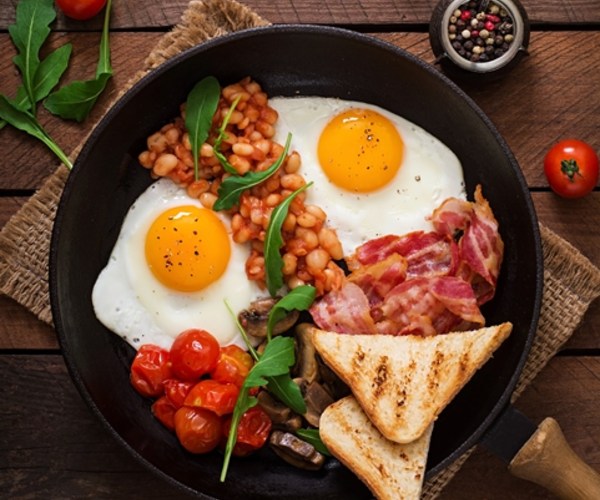
Just Grab & Go
With the ongoing trend, Breakfast has become very much a grab-and-go meal concept due to unavailability of time amongst people.
People tend to eat in the car or at their desk at work. Yes, that’s how it has evolved since. Breakfast sandwiches and burritos are favorites with the commuting crowd, about two-thirds of restaurant morning meals are eaten off-premises and disappointingly, is not considered that important a meal.
Global QSR chain McDonald’s has already made headlines for spreading and investing into its breakfast segment. From serving the best easy-to-grab meals to focusing on healthy breakfast menu, McDonald’s is the business in this line for their strategies serve the purpose of offering food at a quick pace.

Has to be Fast & Fresh
With consumers typically rushed at breakfast time, quick service accounts for 79 percent of total restaurant morning meals, according to NPD. Even at restaurants, guests expect a quick pace at breakfast. Ideally, guests have the notion that they won’t have to wait around long for their food. An emphasis on prep work and batch work helps the scratch kitchen keep up with the crowds.
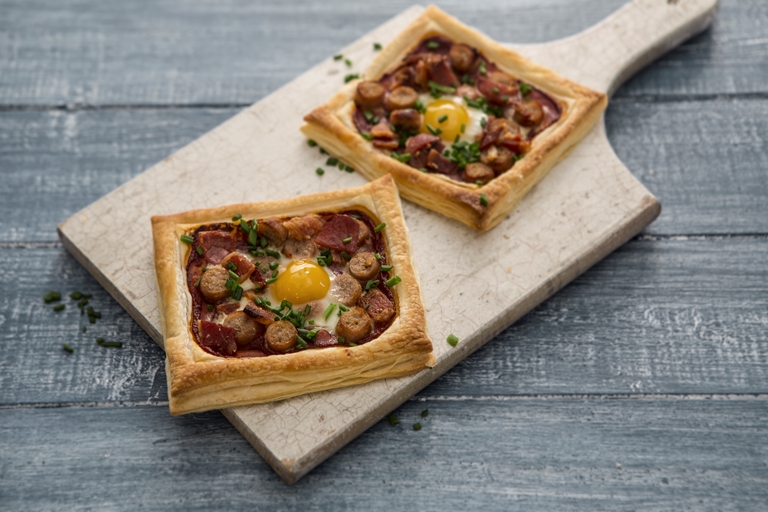
Boost it Up
One way to improve your breakfast business is to serve a better variety of coffees, including options such as lattes or espressos. Popular Coffee Chains like Café Coffee Day & Starbucks has been getting it right since their inception. The morning meal is very much a beverage-driven occasion. High-margin beverages can boost your bottom line.

Prove your Consistency
Breakfast offers huge potential for repeat business because many people get entrenched in morning routines. We have some customers who literally come in every day. Repeat customers expect your restaurant’s eggs, pancakes, and hash browns to be prepared a certain way. Train staff to follow consistent recipes and cooking procedures, and you’ll have guests coming back every morning.
All Day Breakfast
Serve breakfast all day, if logistically feasible. That’s the need of the hour if asked. Nearly 72 percent of all adults wish restaurants would offer breakfast items throughout the day, according to the NRA Forecast. People nowadays are bidding adieu to traditional Indian cuisine and making ways for all-day breakfast specialties, including eggs Benedict, waffles, pancakes and other restaurant’s signature dishes.
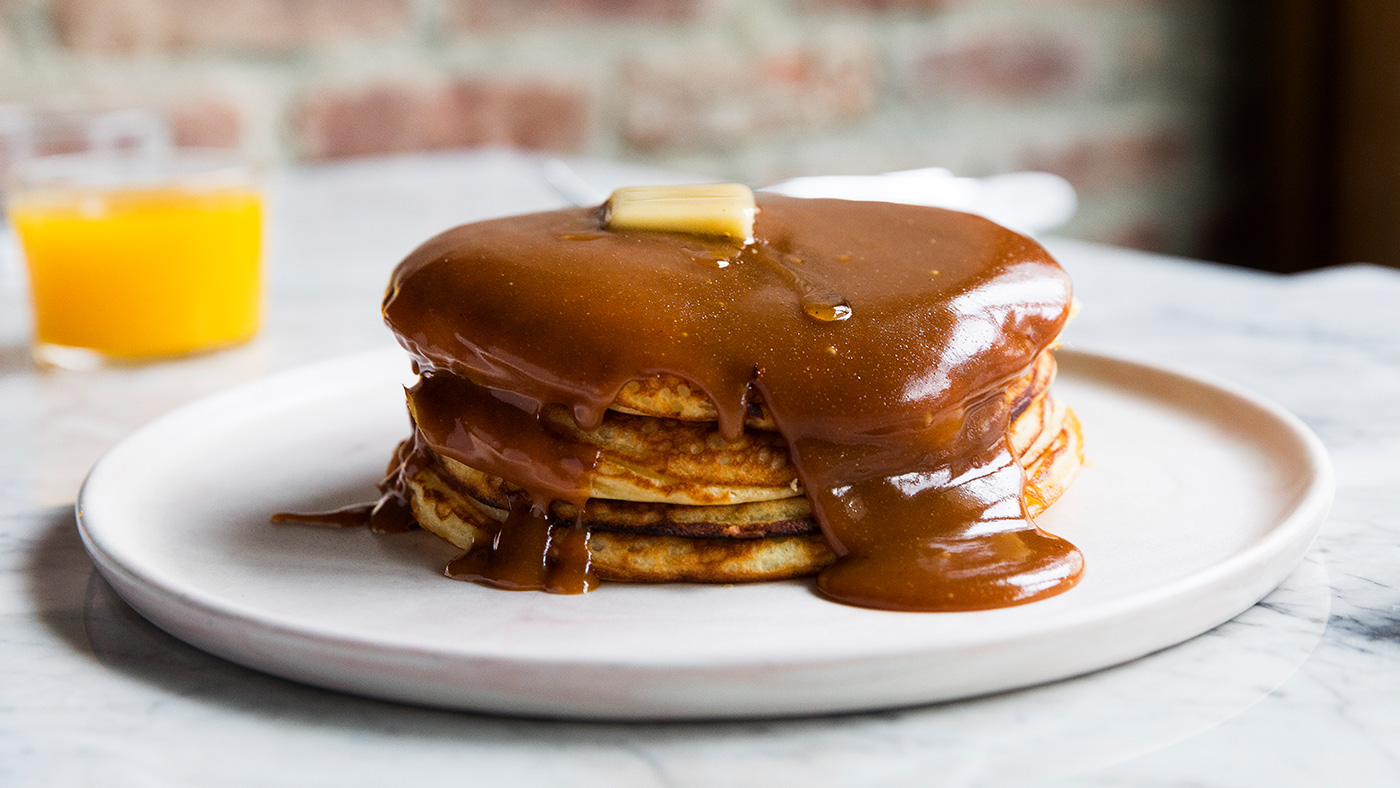
An age-old favourite amongst Dilliwallas the All American Diner continues to be frequented for its breakfast menu. The signature breakfast dishes laden with stacks of pancakes, eggs, sausages, baked beans, grilled tomatoes and fresh breads hit the sweet spot every time.
Even during dinner, about half the guests opt for breakfast items instead of the traditional laid out evening cuisine.

A traveler’s haven, an inmate’s hope or a feeling of indulgence – food is doing such wonderful things around us that no one could have expected. From changing the way we used to visualize food, restaurants, cafes, and lounges, India is at par with the West, when it comes to making money out of food. Pushing the boundaries of convention, entrepreneurs have good and quirky restaurant ideas with unique themes and posh locations.
Taking the trend of themed restaurants to a new height are these unique restaurants that are raising the bar and toppling down the casual eateries with their quirky business ideas etc to go with the pace of development.
Must say, this business in town is flooding wiith new concepts and themes and it is here to stay.
Running on concept
Before you settle on one particular concept, deciding on the audience happens to be your first task. Particulars regarding the price range or different type of food come later on. To be on point, your restaurant design theme can blur the line between concepts to make it unique.

Kaidi’s Kitchen was started by three friends Rohit Ojha, Ankit Madhogaria and Saurav Aggarwal, who were of the belief that,” It is an imprisonment of sorts, mainly indulgence. And the decor captured this sentiment quirkily, with the prison-inspired cells and the Kaidis serving as props. It isn't just dining anymore; it is an experience that is to be relished delightfully.”
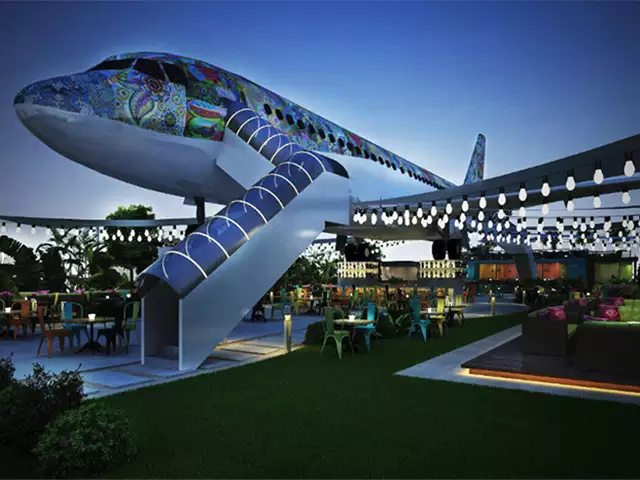
The Brainchild of Parampreet Singh Luthra, Hawaii Adda, has been altered into a swanky restaurant from a scrap airplane. Beating all odds, this chic restaurant successfully managed to get an old plane, without an engine and also got it re-modelled.
With growing excitement buzzing in the minds of people, it gained instant popularity on social media and the brand became popular overnight.
“We are very happy with the concept. I believe two things make a restaurant- food and concept. We have both of them in the right places”, said Parampreet Singh Luthra, Owner, Hawaii Adda.
Designs Leave an Imprint
Historically, restaurants referred only to places that provided tables where one sat down to eat the meal, typically served by a waiter. Following the rise of street food and take-away restaurants, the older restaurant standards have been diminished with people wanting more from just a sit-down restaurant.
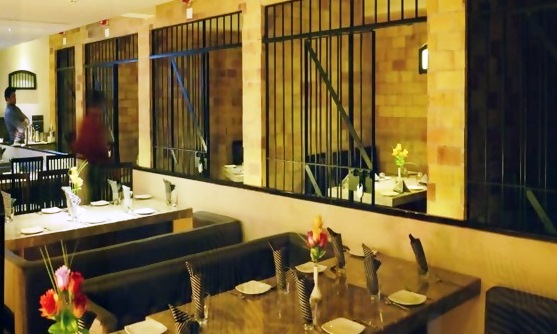
”The restaurant was made in such a way that if a person is sitting at their outlet he doesn’t get bored. The decor and designing part is done very smartly so that it doesn’t look unhygienic and dull because of the bricks they have used to give it a prison look, because food is all about having an all-over experience", adds Ojha.
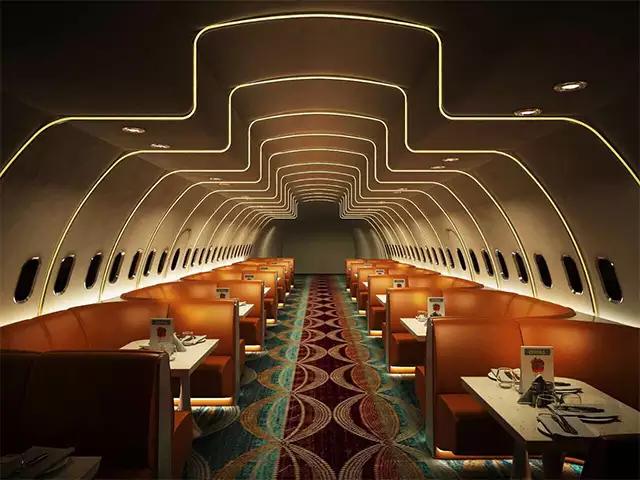
Commenting on the same, Luthra shared his experience in building this out of the box concept. There were many people involved in getting us a plane. Initially, it was very difficult to get a plane wherein I can reshape my dream into reality, but a company helped us to get an old plane without an engine and also get it re-modelled.”
What’s New?
Theme based restaurants are almost always located in major tourist destinations. Included are those markets that attract a variety of groups. Other than hosting special occasion events, theme restaurants seem to have minimal appeal to local residents.
To be in the business, big names are exploring new and creative options for their customers. Looking to the future, theme restaurants industry will continue to be a good fit.

The noise in the restaurant can easily affect the impression of a restaurant to its customer. Regarded as a serious health hazard globally, the restaurant should take care of the permissible noise level at the vicinity. Restaurateurs should make sure that their venture is noise free as customers don’t want to dine at a restaurant where headache and food is served together. Apart from the customers, the side effects of noise can be seen on the employees, who later on end up with serious hearing ailments. “Customers look for three things when they visit their preferred restaurant which including service, price, and ambience. Noise or loud music affects the dining experience in a negative way where customers generally start feeling irritated,” says Anthony Wilson, Mixologist and operational director, Sta8up bar.
Most of the Indian restaurants are operating at 80 decibels which is an appropriate level for pleasant sound. But there are restaurants that operate at about 110 decibels where music remains no more music and d is transformed into noise.
“We as a restaurateurs want to give our guests a pleasant experience, not a headache. People come to eat with their family and friends and spend some quality time with each other. So, it is mandatory to keep the music volume low,” explains Manika Jagdish Pahwa, Owner, Wood Box Café.
Getting curtains and tablecloths
Curtains are very useful when it comes to reducing unwanted light and softening the sounds. The quality of the curtains generally decides how much sound it is going to absorb. Thus, most of the restaurants focus on having curtains with heavier drapes which soften sounds the most. Tablecloths on the other hand also work in the same aid. They reduce the clattering sound of silverware and glassware placed on the table. Again the quality of the linen decides how much sound it is going to absorb. The quieter effect which the tablecloth provides is generally something very positive.
Keep the machinery away from the dining area
It is very obvious to place your machineries away from the dining area where customers are having their food. You should be very smart in placing these machineries to a place which reduces sound to a maximum extent providing a calm environment at the restaurant. Installing your machines near the dining area can be irritating as well as disrupting to the diners. Adding a roof-mounted condenser in the machine can help in absorbing most of the sound coming from it.
Thus, we can surely say that the restaurant's atmosphere affects the profitability especially when it comes to restaurant’s sound. Sounds usually give birth to disruption which is not good for business. Customers define their experience by how comfortable they feel at the restaurant where sounds certainly add a negative effect. Asking the customers what they think about the sound available at the restaurant can help in getting the right amount of sound level at a particular venue.

People have now understood the scope they have for sustaining their business in the food industry. But they usually undermine the level of competitions and various details that they have to perfect in order to mark their presence in the food industry.
Most of the people have thought of coming up with their own venture at least once in their life. But as we know it’s easier said than done. Running one’s own restaurant is a tough business with several challenges tagging along. With the customer’s expectation changing and the introduction of new technologies, things have become more difficult for the restaurateurs in order to survive in the market while promoting their brand.
But by understanding the following challenges, things can work in their favor marking their brands' presence in the market.
The Menu
One of the common problems that a restaurant faces is the menu. Menu designing is said to be a balancing act. Having too many dishes on the menu or overpricing your dishes can act against your brand. The owner should keep the menu size in check. They should consider offering quality over quantity. “A menu is something which I consider as a soul of a restaurant. We gave a lot of time while designing our menu which would be easy to read and understand so that our customer can order their preferred dishes without getting confused,” says Sandeep Tandon, owner of Shikhara Fine Dining Restaurant.
Customer Service
Customer service is yet another challenge which the restaurateur faces. It is said that your food may be outstanding and delicious, but if your service is bad then you are sure to lose your customers. With growing digitalisation, people prefer to read reviews of your restraint prior to their visit. “We train and educate our staffs before they are present in front of our customers. They should be serving happiness along with the cuisines which a customer demands. In our absence, the venue is known by the staff and food served. We provide a family environment to our staffs so that they love what they are doing,” shares Rohan Saraf, Owner, Roadhouse Café.
Management
Management can be referred as one of the most crucial aspect of a business. Analyzing your business is one important thing for running your venture. Most of the startups lack in this area. In spite of having great ideas, the restaurants fail due to the absence of a strong management team.
Hiring and Staff Management
It is really very important to hire and train the suitable candidates for your restaurant. Being the face of your brand, your staff can make or break your brand reputation. Training and educating them right followed by keeping them enthusiastic and motivated can certainly help a restaurant overcome this hurdle.
Capital
This is a segment where many restaurateurs run into a big problem. Capital can be referred as the foundation of a restaurant without which several problems and challenges can creep up. Restaurant owners need a good capital and financial support to run their venture smoothly. Once again, proper and efficient financial management plays a crucial role in running a restaurant.
Keeping all these points in mind can certainly help restaurateurs build and sustain their brand in the market.

It is often believed that happy faces bring the best to the table and similarly, a happy manager is an important part of the restaurant business. We have heard restaurant owners talking about their ‘team’ as an important part of their business and often it is one of the biggest challenges to get the best staff and team. Treated as the heart and soul of the restaurant, a manager knows his staff and customers very well, thereby making the restaurants run smoothly drawing the best of the business. But with all the glam that the manager’s job offers, they are moving out for better opportunities. Restaurant industry faces the highest attrition challenges because of the work pressure that it creates for its staff.
“We are one big family at Massive and we encourage our team members to take some time off, spend time with their families. Alongside, we have off-sites planned, family days etc,” shares Zorawar Kalra, Founder & MD, Massive Restaurants adding that awarding and rewarding is a done thing however, acknowledging their efforts and hard work is of utmost importance.
These days restaurant managers leave their jobs at top restaurants opting for a start-up restaurant because of quite a few reasons which include appreciation and good pay offs. “We have hired the best of the talents from the industry and given all of them a promotion trying our best to match their salary expectations,” says Abhinav Aggarwal of recently opened Café StayWoke at South Point Mall Gurgaon. The group has never believed in negotiation thinking that if the staffs are working for them, they should be satisfied and happy in their own terms. “We provide a lot of incentives which keeps the competition among the staffs alive. We also don’t try to question them if they are willing to have a holiday,” adds Manali Guha, the Co-Founder of the café who is trying to introduce the MNC culture at their restaurant.
Sharing a similar story Chef Om Nayak who runs The Pasta Bowl Company points that he never asks his staff to work if they are upset or don’t feel like working as it will falter in the food and service. “This goes for both my chefs and servers as this would hamper the service and food,” adds Nayak who has almost has 0% of the attrition rate at his restaurant. Hence, we can say that every restaurant owners know that a good team is very important. The pillar of an organization thrives on its team. But they somehow lag or miss on making their team and staff happy. “We at Massive have a very intense & streamlined process of selection &this is how we can proudly say we have the best in industry,” concludes Kalra who has award winning restaurants like Masala Library, Farzi Café to his hat.
Copyright © 2009 - 2025 Restaurant India.





